Agriculture
| Agriculture |
|---|
 |
|
|


Agriculture is the cultivation of animals, plants, fungi, and other life forms for food, fiber, biofuel, medicinal and other products used to sustain and enhance human life.[1] Agriculture was the key development in the rise of sedentary human civilization, whereby farming of domesticated species created food surpluses that nurtured the development of civilization. The study of agriculture is known as agricultural science. The history of agriculture dates back thousands of years, and its development has been driven and defined by greatly different climates, cultures, and technologies. However, all farming generally relies on techniques to expand and maintain the lands that are suitable for raising domesticated species. For plants, this usually requires some form of irrigation, although there are methods of dryland farming. Livestock are raised in a combination of grassland-based and landless systems, in an industry that covers almost one-third of the world's ice- and water-free area. In the developed world, industrial agriculture based on large-scale monoculture has become the dominant system of modern farming, although there is growing support for sustainable agriculture, including permaculture and organic agriculture.
Until the Industrial Revolution, the vast majority of the human population labored in agriculture. Pre-industrial agriculture was typically subsistence agriculture/self-sufficiency in which farmers raised most of their crops for their own consumption instead of cash crops for trade. A remarkable shift in agricultural practices has occurred over the past century in response to new technologies and the development of world markets. This also has led to technological improvements in agricultural techniques such as the Haber-Bosch method for synthesizing ammonium nitrate which made the traditional practice of recycling nutrients with crop rotation and animal manure less important.
Modern agronomy, plant breeding, agrochemicals such as pesticides and fertilizers, and technological improvements have sharply increased yields from cultivation, but at the same time have caused widespread ecological damage and negative human health effects. Selective breeding and modern practices in animal husbandry have similarly increased the output of meat, but have raised concerns about animal welfare and the health effects of the antibiotics, growth hormones, and other chemicals commonly used in industrial meat production. Genetically modified organisms are an increasing component of agriculture, although they are banned in several countries. Agricultural food production and water management are increasingly becoming global issues that are fostering debate on a number of fronts. Significant degradation of land and water resources, including the depletion of aquifers, has been observed in recent decades, and the effects of global warming on agriculture and of agriculture on global warming are still not fully understood.
The major agricultural products can be broadly grouped into foods, fibers, fuels, and raw materials. Specific foods include cereals (grains), vegetables, fruits, oils, meats and spices. Fibers include cotton, wool, hemp, silk and flax. Raw materials include lumber and bamboo. Other useful materials are produced by plants, such as resins, dyes, drugs, perfumes, biofuels and ornamental products such as cut flowers and nursery plants. Over one third of the world's workers are employed in agriculture, second only to the services' sector, although the percentages of agricultural workers in developed countries has decreased significantly over the past several centuries.
Etymology and terminology
The word agriculture is a late Middle English adaptation of Latin agricultūra, from ager, "field", and cultūra, "cultivation" or "growing".[2] Agriculture usually refers to human activities, although it is also observed in certain species of ant, termite and ambrosia beetle.[3] To practice agriculture means to use natural resources to "produce commodities which maintain life, including food, fiber, forest products, horticultural crops, and their related services."[4] This definition includes arable farming or agronomy, and horticulture, all terms for the growing of plants, animal husbandry and forestry.[4] A distinction is sometimes made between forestry and agriculture, based on the former's longer management rotations, extensive versus intensive management practices and development mainly by nature, rather than by man. Even then, it is acknowledged that there is a large amount of knowledge transfer and overlap between silviculture (the management of forests) and agriculture.[5] In traditional farming, the two are often combined even on small landholdings, leading to the term agroforestry.[6]
History
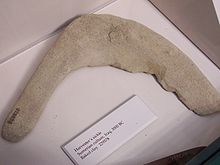
| Agriculture |
|---|
 |
|
|
| Rural Society |
|---|
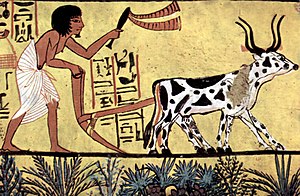
Agriculture began independently in different parts of the globe, and included a diverse range of taxa. At least eleven separate regions of the Old and New World were involved as independent centers of origin. The development of agriculture about 12,000 years ago changed the way humans lived. They switched from nomadic hunter-gatherer lifestyles to permanent settlements and farming.[7]
Wild grains were collected and eaten from at least 104,000 years ago.[8] However, domestication did not occur until much later. The earliest evidence of small-scale cultivation of edible grasses is from around 21,000 BC with the Ohalo II people on the shores of the Sea of Galilee.[9] By around 9500 BC, the eight Neolithic founder crops – emmer wheat, einkorn wheat, hulled barley, peas, lentils, bitter vetch, chickpeas, and flax – were cultivated in the Levant.[10] Rye may have been cultivated earlier, but this claim remains controversial.[11] Regardless, rye's spread from Southwest Asia to the Atlantic was independent of the Neolithic founder crop package.[12] Rice was domesticated in China by 6200 BC[13] with earliest known cultivation from 5700 BC, followed by mung, soy and azuki beans. Rice was also independently domesticated in West Africa and cultivated by 1000 BC.[14][15] Pigs were domesticated in Mesopotamia around 11,000 years ago, followed by sheep. Cattle were domesticated from the wild aurochs in the areas of modern Turkey and India around 8500 BC. Camels were domesticated late, perhaps around 3000 BC.
In subsaharan Africa, sorghum was domesticated in the Sahel region of Africa by 3000 BC, along with pearl millet by 2000 BC.[16][17] Yams were domesticated in several distinct locations, including West Africa (unknown date), and cowpeas by 2500 BC.[18][19] Rice (African rice) was also independently domesticated in West Africa and cultivated by 1000 BC.[14][15] Teff and likely finger millet were domesticated in Ethiopia by 3000 BC, along with noog, ensete, and coffee.[20][21] Other plant foods domesticated in Africa include watermelon, okra, tamarind and black eyed peas, along with tree crops such as the kola nut and oil palm.[22] Plantains were cultivated in Africa by 3000 BC and bananas by 1500 BC.[23][24] The helmeted guineafowl was domesticated in West Africa.[25] Sanga cattle was likely also domesticated in North-East Africa, around 7000 BC, and later crossbred with other species.[26][27]
In South America, agriculture began as early as 9000 BC, starting with the cultivation of several species of plants that later became only minor crops. In the Andes of South America, the potato was domesticated between 8000 BC and 5000 BC, along with beans, squash, tomatoes, peanuts, coca, llamas, alpacas, and guinea pigs. Cassava was domesticated in the Amazon Basin no later than 7000 BC. Maize (Zea mays) found its way to South America from Mesoamerica, where wild teosinte was domesticated about 7000 BC and selectively bred to become domestic maize. Cotton was domesticated in Peru by 4200 BC; another species of cotton was domesticated in Mesoamerica and became by far the most important species of cotton in the textile industry in modern times.[28] Evidence of agriculture in the Eastern United States dates to about 3000 BCE. Several plants were cultivated, later to be replaced by the Three Sisters cultivation of maize, squash, and beans.
Sugarcane and some root vegetables were domesticated in New Guinea around 7000 BC. Bananas were cultivated and hybridized in the same period in Papua New Guinea. In Australia, agriculture was invented at a currently unspecified period, with the oldest eel traps of Budj Bim dating to 6,600 BC[29] and the deployment of several crops ranging from yams[30] to bananas.[31]
The Bronze Age, from c. 3300 BC, witnessed the intensification of agriculture in civilizations such as Mesopotamian Sumer, ancient Egypt, ancient Sudan, the Indus Valley civilisation of the Indian subcontinent, ancient China, and ancient Greece. From 100 BC to 1600 AD, world population continued to grow along with land use, as evidenced by the rapid increase in methane emissions from cattle and the cultivation of rice.[32] During the Iron Age and era of classical antiquity, the expansion of ancient Rome, both the Republic and then the Empire, throughout the ancient Mediterranean and Western Europe built upon existing systems of agriculture while also establishing the manorial system that became a bedrock of medieval agriculture. In the Middle Ages, both in Europe and in the Islamic world, agriculture was transformed with improved techniques and the diffusion of crop plants, including the introduction of sugar, rice, cotton and fruit trees such as the orange to Europe by way of Al-Andalus. After the voyages of Christopher Columbus in 1492, the Columbian exchange brought New World crops such as maize, potatoes, tomatoes, sweet potatoes, and manioc to Europe, and Old World crops such as wheat, barley, rice, and turnips, and livestock including horses, cattle, sheep, and goats to the Americas.
Irrigation, crop rotation, and fertilizers were introduced soon after the Neolithic Revolution and developed much further in the past 200 years, starting with the British Agricultural Revolution. Since 1900, agriculture in the developed nations, and to a lesser extent in the developing world, has seen large rises in productivity as human labour has been replaced by mechanization, and assisted by synthetic fertilizers, pesticides, and selective breeding. The Haber-Bosch process allowed the synthesis of ammonium nitrate fertilizer on an industrial scale, greatly increasing crop yields. Modern agriculture has raised social, political, and environmental issues including overpopulation, water pollution, biofuels, genetically modified organisms, tariffs and farm subsidies. In response, organic farming developed in the twentieth century as an alternative to the use of synthetic pesticides.
Origins
Origin hypotheses

Scholars have developed a number of hypotheses to explain the historical origins of agriculture. Studies of the transition from hunter-gatherer to agricultural societies indicate an antecedent period of intensification and increasing sedentism; examples are the Natufian culture in the Levant, and the Early Chinese Neolithic in China. Current models indicate that wild stands that had been harvested previously started to be planted, but were not immediately domesticated.[33][34]
Localised climate change is the favoured explanation for the origins of agriculture in the Levant.[7] When major climate change took place after the last ice age (c. 11,000 BC), much of the earth became subject to long dry seasons.[35] These conditions favoured annual plants which die off in the long dry season, leaving a dormant seed or tuber. An abundance of readily storable wild grains and pulses enabled hunter-gatherers in some areas to form the first settled villages at this time.[7]
Early development

Early people began altering communities of flora and fauna for their own benefit through means such as fire-stick farming and forest gardening very early.[36][37][38] Wild grains have been collected and eaten from at least 105,000 years ago, and possibly much longer.[8] Exact dates are hard to determine, as people collected and ate seeds before domesticating them, and plant characteristics may have changed during this period without human selection. An example is the semi-tough rachis and larger seeds of cereals from just after the Younger Dryas (about 9500 BC) in the early Holocene in the Levant region of the Fertile Crescent. Monophyletic characteristics were attained without any human intervention, implying that apparent domestication of the cereal rachis could have occurred quite naturally.[39]
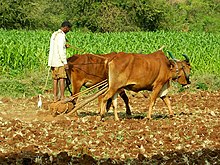
Agriculture began independently in different parts of the globe and included a diverse range of taxa. At least 11 separate regions of the Old and New World were involved as independent centers of origin.[40] Some of the earliest known domestications were of animals. Domestic pigs had multiple centres of origin in Eurasia, including Europe, East Asia and Southwest Asia,[41] where wild boar were first domesticated about 10,500 years ago.[42] Sheep were domesticated in Mesopotamia between 11,000 BC and 9000 BC.[43] Cattle were domesticated from the wild aurochs in the areas of modern Turkey and India around 8500 BC.[44] Camels were domesticated relatively late, perhaps around 3000 BC.[45]
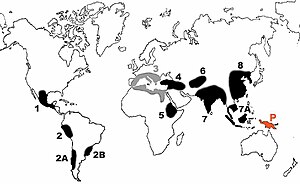
It was not until after 9500 BC that the eight so-called founder crops of agriculture appear: first emmer and einkorn wheat, then hulled barley, peas, lentils, bitter vetch, chick peas and flax. These eight crops occur more or less simultaneously on Pre-Pottery Neolithic B (PPNB) sites in the Levant, although wheat was the first to be grown and harvested on a significant scale.[citation needed][dubious ] At around the same time (9400 BC), parthenocarpic fig trees were domesticated.[47][48]
Domesticated rye occurs in small quantities at some Neolithic sites in (Asia Minor) Turkey, such as the Pre-Pottery Neolithic B (c. 7600 – c. 6000 BC) Can Hasan III near Çatalhöyük,[49] but is otherwise absent until the Bronze Age of central Europe, c. 1800–1500 BC.[50] Claims of much earlier cultivation of rye, at the Epipalaeolithic site of Tell Abu Hureyra in the Euphrates valley of northern Syria, remain controversial.[51] Critics point to inconsistencies in the radiocarbon dates, and identifications based solely on grain, rather than on chaff.[52]
By 8000 BC, farming was entrenched on the banks of the Nile. About this time, agriculture was developed independently in the Far East, probably in China, with rice rather than wheat as the primary crop. Maize was domesticated from the wild grass teosinte in southern Mexico by 6700 BC.[53] The potato (8000 BC), tomato,[54] pepper (4000 BC), squash (8000 BC) and several varieties of bean (8000 BC onwards) were domesticated in the New World.[citation needed]
Agriculture was independently developed on the island of New Guinea.[55] Banana cultivation of Musa acuminata, including hybridization, dates back to 5000 BC, and possibly to 8000 BC, in Papua New Guinea.[56][57]
Bees were kept for honey in the Middle East around 7000 BC.[58] Archaeological evidence from various sites on the Iberian peninsula suggest the domestication of plants and animals between 6000 and 4500 BC.[59] Céide Fields in Ireland, consisting of extensive tracts of land enclosed by stone walls, date to 3500 BC and are the oldest known field systems in the world.[60][61] The horse was domesticated in the Pontic steppe around 4000 BC.[62] In Siberia, Cannabis was in use in China in Neolithic times and may have been domesticated there; it was in use both as a fibre for ropemaking and as a medicine in Ancient Egypt by about 2350 BC.[63]
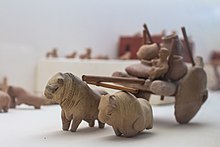
In northern China, millet was domesticated by early Sino-Tibetan speakers at around 8000 to 6000 BC, becoming the main crop of the Yellow River basin by 5500 BC.[64][65] They were followed by mung, soy and azuki beans.
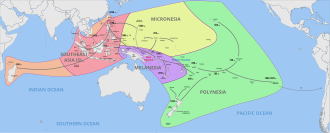
In southern China, rice was domesticated in the Yangtze River basin at around 11,500 to 6200 BC, along with the development of wetland agriculture, by early Austronesian and Hmong-Mien-speakers. Other food plants were also harvested, including acorns, water chestnuts, and foxnuts.[13][64][67][68] Rice cultivation was later spread to Maritime Southeast Asia by the Austronesian expansion, starting at around 3,500 to 2,000 BC. This migration event also saw the introduction of cultivated and domesticated food plants from Taiwan, Maritime Southeast Asia, and New Guinea into the Pacific Islands as canoe plants. Contact with Sri Lanka and Southern India by Austronesian sailors also led to an exchange of food plants which later became the origin of the valuable spice trade.[69][70][71] In the 1st millennium AD, Austronesian sailors also settled Madagascar and the Comoros, bringing Southeast Asian and South Asian food plants with them to the East African coast, including bananas and rice.[72][73] Rice was also spread southwards into Mainland Southeast Asia by around 2000 to 1500 BC by the migrations of the early Austroasiatic and Kra-Dai-speakers.[67]
In the Sahel region of Africa, sorghum was domesticated by 3000 BC in Sudan[74] and pearl millet by 2500 BC in Mali.[75] Kola nut and coffee were also domesticated in Africa.[76] In New Guinea, ancient Papuan peoples began practicing agriculture around 7000 BC, domesticating sugarcane and taro.[77] In the Indus Valley from the eighth millennium BC onwards at Mehrgarh, 2-row and 6-row barley were cultivated, along with einkorn, emmer, and durum wheats, and dates. In the earliest levels of Merhgarh, wild game such as gazelle, swamp deer, blackbuck, chital, wild ass, wild goat, wild sheep, boar, and nilgai were all hunted for food. These are successively replaced by domesticated sheep, goats, and humped zebu cattle by the fifth millennium BC, indicating the gradual transition from hunting and gathering to agriculture.[78]
Maize and squash were domesticated in Mesoamerica; potatoes in South America, and sunflowers in the Eastern Woodlands of North America.[79]
Civilizations
Sumer

Sumerian farmers grew the cereals barley and wheat, starting to live in villages from about 8000 BC. Given the low rainfall of the region, agriculture relied on the Tigris and Euphrates rivers. Irrigation canals leading from the rivers permitted the growth of cereals in large enough quantities to support cities. The first ploughs appear in pictographs from Uruk around 3000 BC; seed-ploughs that funneled seed into the ploughed furrow appear on seals around 2300 BC. Vegetable crops included chickpeas, lentils, peas, beans, onions, garlic, lettuce, leeks and mustard. They grew fruits including dates, grapes, apples, melons, and figs. Alongside their farming, Sumerians also caught fish and hunted fowl and gazelle. The meat of sheep, goats, cows and poultry was eaten, mainly by the elite. Fish was preserved by drying, salting and smoking.[80][81]
Ancient Egypt
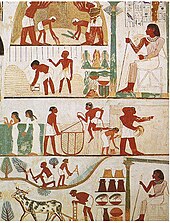
The civilization of Ancient Egypt was indebted to the Nile River and its dependable seasonal flooding. The river's predictability and the fertile soil allowed the Egyptians to build an empire on the basis of great agricultural wealth. Egyptians were among the first peoples to practice agriculture on a large scale, starting in the pre-dynastic period from the end of the Paleolithic into the Neolithic, between around 10,000 BC and 4000 BC.[82] This was made possible with the development of basin irrigation.[83] Their staple food crops were grains such as wheat and barley, alongside industrial crops such as flax and papyrus.[82] Archaeological evidence also suggests that the spread of agriculture was facilitated by the influx of farming communities from the tropical Sahara 6,500 years ago.[84]
Indian Subcontinent
Jujube was domesticated in the Indian subcontinent by 9000 BC.[85] Barley and wheat cultivation – along with the domestication of cattle, primarily sheep and goats – followed in Mehrgarh culture by 8000–6000 BC.[86][87][88] This period also saw the first domestication of the elephant.[85] Pastoral farming in India included threshing, planting crops in rows – either of two or of six – and storing grain in granaries.[87][89] Cotton was cultivated by the 5th–4th millennium BC.[90] By the 5th millennium BC, agricultural communities became widespread in Kashmir.[87] Irrigation was developed in the Indus Valley Civilisation by around 4500 BC.[91] The size and prosperity of the Indus civilization grew as a result of this innovation, leading to more thoroughly planned settlements which used drainage and sewers.[91] Archeological evidence of an animal-drawn plough dates back to 2500 BC in the Indus Valley Civilization.[92]
Ancient China

Records from the Warring States, Qin dynasty, and Han dynasty provide a picture of early Chinese agriculture from the 5th century BC to 2nd century AD which included a nationwide granary system and widespread use of sericulture. An important early Chinese book on agriculture is the Qimin Yaoshu of AD 535, written by Jia Sixie.[93] Jia's writing style was straightforward and lucid relative to the elaborate and allusive writing typical of the time. Jia's book was also very long, with over one hundred thousand written Chinese characters, and it quoted many other Chinese books that were written previously, but no longer survive.[94] The contents of Jia's 6th century book include sections on land preparation, seeding, cultivation, orchard management, forestry, and animal husbandry. The book also includes peripherally related content covering trade and culinary uses for crops.[95] The work and the style in which it was written proved influential on later Chinese agronomists, such as Wang Zhen and his groundbreaking Nong Shu of 1313.[94]

For agricultural purposes, the Chinese had innovated the hydraulic-powered trip hammer by the 1st century BC.[96] Although it found other purposes, its main function to pound, decorticate, and polish grain that otherwise would have been done manually. The Chinese also began using the square-pallet chain pump by the 1st century AD, powered by a waterwheel or oxen pulling an on a system of mechanical wheels.[97] Although the chain pump found use in public works of providing water for urban and palatial pipe systems,[98] it was used largely to lift water from a lower to higher elevation in filling irrigation canals and channels for farmland.[99] By the end of the Han dynasty in the late 2nd century, heavy ploughs had been developed with iron ploughshares and mouldboards.[100][101] These slowly spread west, revolutionizing farming in Northern Europe by the 10th century. (Thomas Glick, however, argues for a development of the Chinese plough as late as the 9th century, implying its spread east from similar designs known in Italy by the 7th century.)[102]
Asian rice was domesticated 8,200–13,500 years ago in China, with a single genetic origin from the wild rice Oryza rufipogon,[13] in the Pearl River valley region of China. Rice cultivation then spread to South and Southeast Asia.[103]
Ancient Greece and Hellenistic world

The major cereal crops of the ancient Mediterranean region were wheat, emmer, and barley, while common vegetables included peas, beans, fava, and olives, dairy products came mostly from sheep and goats, and meat, which was consumed on rare occasion for most people, usually consisted of pork, beef, and lamb.[104] Agriculture in ancient Greece was hindered by the topography of mainland Greece that only allowed for roughly 10% of the land to be cultivated properly, necessitating the specialised exportation of oil and wine and importation of grains from Thrace (centered in what is now Bulgaria) and the Greek colonies of Pontic Greeks near the Black Sea. During the Hellenistic period, the Ptolemaic Empire controlled Egypt, Cyprus, Phoenicia, and Cyrenaica, major grain-producing regions that mainland Greeks depended on for subsistence, while the Ptolemaic grain market also played a critical role in the rise of the Roman Republic. In the Seleucid Empire, Mesopotamia was a crucial area for the production of wheat, while nomadic animal husbandry was also practiced in other parts.[105]
Roman Empire
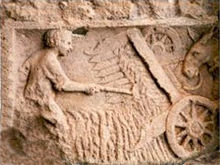
In the Greco-Roman world of Classical antiquity, Roman agriculture was built on techniques originally pioneered by the Sumerians, transmitted to them by subsequent cultures, with a specific emphasis on the cultivation of crops for trade and export. The Romans laid the groundwork for the manorial economic system, involving serfdom, which flourished in the Middle Ages. The farm sizes in Rome can be divided into three categories. Small farms were from 18 to 88 iugera (one iugerum is equal to about 0.65 acre). Medium-sized farms were from 80 to 500 iugera (singular iugerum). Large estates (called latifundia) were over 500 iugera. The Romans had four systems of farm management: direct work by the owner and his family; slaves doing work under the supervision of slave managers; tenant farming or sharecropping in which the owner and a tenant divide up a farm's produce; and situations in which a farm was leased to a tenant.[106]
The Americas
Agricultural history took a different path from the Old World as the Americas lacked large-seeded, easily domesticated grains (such as wheat and barley) and large domestic animals that could be used for agricultural labor. Rather than the practice which developed in the Old World of sowing a field with a single crop, pre-historic American agriculture usually consisted of cultivating many crops close to each other utilizing only hand labor. Moreover, agricultural areas in the Americas lacked the uniformity of the east–west area of Mediterranean and semi-arid climates in southern Europe and southwestern Asia, but instead had a north–south pattern with a variety of different climatic zones in close proximity to each other. This fostered the domestication of many different plants.[107]
At the time of first contact between the Europeans and the Americans, the Europeans practiced "extensive agriculture, based on the plough and draught animals," with tenants under landlords, but also forced labor or slavery, while the Indigenous peoples of the Americas practiced "intensive agriculture, based on human labour."[108] Europeans wanted control of land for the grazing of their livestock and property rights for the control of production. Though they were impressed with the productivity of traditional farming techniques, they saw no connection to their system and were dismissive of Native American practices as "gardening" rather than a commercializable enterprise.[108][109] Due to several thousand years of selective breeding, maize, the hemisphere's most important crop, was more productive than Old World grain crops. Maize produced two and one-half times more calories per acre than wheat and barley.[110]
South America


The earliest known areas of possible agriculture in the Americas dating to about 9000 BC are in Colombia, near present-day Pereira, and by the Las Vegas culture in Ecuador on the Santa Elena peninsula. The plants cultivated (or manipulated by humans) were lerén (Calathea allouia), arrowroot (Maranta arundinacea), squash (Cucurbita species), and bottle gourd (Lagenaria siceraria). All are plants of humid climates and their existence at this time on the semi-arid Santa Elena peninsula may be evidence that they were transplanted there from more humid environments.[111][112] In another study, this area of South America was identified as one of the four oldest places of origin for agriculture, along with the Fertile Crescent, China, and Mesoamerica, dated between 6200 BC and 10000 BC.[113] (To facilitate comprehension by readers, Radiocarbon calibrated BP dates in the above sources have been converted to BC.)
In the Andes region, with civilizations including the Inca, the major crop was the potato, domesticated between 8000 and 5000 BC.[114][115][116] Coca, still a major crop to this day, was domesticated in the Andes, as were the peanut, tomato, tobacco, and pineapple.[77] Cotton was domesticated in Peru by 4200 BC.[117][118] Animals were also domesticated, including llamas, alpacas, and guinea pigs.[119] The people of the Inca Empire of South America grew large surpluses of food which they stored in buildings called Qullqas.[120]
The most important crop domesticated in the Amazon Basin and tropical lowlands was probably cassava, (Manihot esculenta), which was domesticated before 7000 BCE, likely in the Rondônia and Mato Grosso states of Brazil.[121] The Guaitecas Archipelago in modern Chile was the southern limit of Pre-Hispanic agriculture near 44° South latitude,[122] as noted by the mention of the cultivation of Chiloé potatoes by a Spanish expedition in 1557.[123]
Mesoamerica

In Mesoamerica, wild teosinte was transformed through human selection into the ancestor of modern maize, about 7,000 BC. It gradually spread across North America and to South America and was the most important crop of Native Americans at the time of European exploration.[124] Other Mesoamerican crops include hundreds of varieties of locally domesticated squash and beans, while cocoa, also domesticated in the region, was a major crop.[77] The turkey, one of the most important poultry birds, was probably domesticated in Mexico or the U.S. Southwest.[125]
In Mesoamerica, the Aztecs were active farmers and had an agriculturally focused economy. The land around Lake Texcoco was fertile, but not large enough to produce the amount of food needed for the population of their expanding empire. The Aztecs developed irrigation systems, formed terraced hillsides, fertilized their soil, and developed chinampas or artificial islands, also known as "floating gardens". The Mayas between 400 BC to 900 AD used extensive canal and raised field systems to farm swampland on the Yucatán Peninsula.[126][127]
North America

The indigenous people of the Eastern U.S. domesticated numerous crops. Sunflowers, tobacco,[128] varieties of squash and Chenopodium, as well as crops no longer grown, including marsh elder and little barley.[129][130] Wild foods including wild rice and maple sugar were harvested.[131] The domesticated strawberry is a hybrid of a Chilean and a North American species, developed by breeding in Europe and North America.[132] Two major crops, pecans and Concord grapes, were used extensively in prehistoric times but do not appear to have been domesticated until the 19th century.[133][134]
The indigenous people in what is now California and the Pacific Northwest practiced various forms of forest gardening and fire-stick farming in the forests, grasslands, mixed woodlands, and wetlands, ensuring that desired food and medicine plants continued to be available. The natives controlled fire on a regional scale to create a low-intensity fire ecology which prevented larger, catastrophic fires and sustained a low-density agriculture in loose rotation; a sort of "wild" permaculture.[135][136][137][138]
A system of companion planting called the Three Sisters was developed in North America. Three crops that complemented each other were planted together: winter squash, maize (corn), and climbing beans (typically tepary beans or common beans). The maize provides a structure for the beans to climb, eliminating the need for poles. The beans provide the nitrogen to the soil that the other plants use, and the squash spreads along the ground, blocking the sunlight, helping prevent the establishment of weeds. The squash leaves also act as a "living mulch".[139][140]
Sub-Saharan Africa
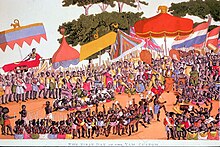
In the Sahel region, civilizations such as the Mali and Songhai empires cultivated sorghum and pearl millet, which were domesticated between 3000 and 2500 BC.[74][75] The donkey was domesticated in Nubia at approximately 5000 BC.[141][142] Archaeological evidence suggests that Sanga cattle may have been independently domesticated in East Africa at around 1600 BC.[143]
In the tropical region of West Africa, crops such as black-eyed peas, Sea Island red peas, yams, kola nuts, Jollof rice and kokoro were domesticated between 3000 and 1000 BC.[76] The coastal region of West Africa is often referred to as the "Yam Belt", due to its high production of yams.[144] The guineafowl is a poultry bird that was domesticated in West Africa, and while the time of the guineafowl's domestication remains unclear, there is evidence that it was present in Ancient Greece during the 5th century BC.[145]
Several species of coffee were also domesticated throughout Sub-Saharan Africa, with Coffea arabica originating in Ethiopia and serving as the main production of modern-day coffee since the late 15th century.[146]
Oceania
Australia
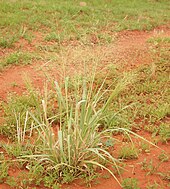
Indigenous Australians were predominately nomadic hunter-gatherers. Due to the policy of terra nullius, Aboriginals were regarded as not having been capable of sustained agriculture. However, the current consensus is that various agricultural methods were employed by the indigenous people.[30][147][31]
In two regions of Central Australia, the central west coast and eastern central Australia, forms of agriculture were practiced. People living in permanent settlements of over 200 residents sowed or planted on a large scale and stored the harvested food. The Nhanda and Amangu of the central west coast grew yams (Dioscorea hastifolia), while various groups in eastern central Australia (the Corners Region) planted and harvested bush onions (yaua – Cyperus bulbosus), native millet (cooly, tindil – Panicum decompositum) and a sporocarp, ngardu (Marsilea drummondii).[36]: 281–304 [34]
Indigenous Australians used systematic burning, fire-stick farming, to enhance natural productivity.[148] In the 1970s and 1980s archaeological research in south west Victoria established that the Gunditjmara and other groups had developed sophisticated eel farming and fish trapping systems over a period of nearly 5,000 years.[149] The archaeologist Harry Lourandos suggested in the 1980s that there was evidence of 'intensification' in progress across Australia,[150] a process that appeared to have continued through the preceding 5,000 years. These concepts led the historian Bill Gammage to argue that in effect the whole continent was a managed landscape.[36]
Torres Strait Islanders are now known to have planted bananas.[31]
Pacific Islands
In New Guinea, archaeological evidence suggests that agriculture independently emerged around 7,000 years ago with the domestication of crops such as bananas and taro. Pigs and chickens were imported to New Guinea, which were later innovated by other Pacific Island nations, such as those in Polynesia.[151]
Middle Ages and Early Modern period
Europe
The Middle Ages saw further improvements in agriculture. Monasteries spread throughout Europe and became important centers for the collection of knowledge related to agriculture and forestry. The manorial system allowed large landowners to control their land and its laborers, in the form of peasants or serfs.[152] During the medieval period, the Arab world was critical in the exchange of crops and technology between the European, Asia and African continents. Besides transporting numerous crops, they introduced the concept of summer irrigation to Europe and developed the beginnings of the plantation system of sugarcane growing through the use of slaves for intensive cultivation.[153]
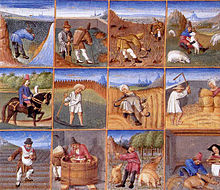
By AD 900, developments in iron smelting allowed for increased production in Europe, leading to developments in the production of agricultural implements such as ploughs, hand tools and horse shoes. The carruca heavy plough improved on the earlier scratch plough, with the adoption of the Chinese mouldboard plough to turn over the heavy, wet soils of northern Europe. This led to the clearing of northern European forests and an increase in agricultural production, which in turn led to an increase in population.[154][155] At the same time, some farmers in Europe moved from a two field crop rotation to a three-field crop rotation in which one field of three was left fallow every year. This resulted in increased productivity and nutrition, as the change in rotations permitted nitrogen-fixing legumes such as peas, lentils and beans.[156] Improved horse harnesses and the whippletree further improved cultivation.[157]
Watermills were introduced by the Romans, but were improved throughout the Middle Ages, along with windmills, and used to grind grains into flour, to cut wood and to process flax and wool.[158]
Crops included wheat, rye, barley and oats. Peas, beans, and vetches became common from the 13th century onward as a fodder crop for animals and also for their nitrogen-fixation fertilizing properties. Crop yields peaked in the 13th century, and stayed more or less steady until the 18th century.[159] Though the limitations of medieval farming were once thought to have provided a ceiling for the population growth in the Middle Ages, recent studies have shown that the technology of medieval agriculture was always sufficient for the needs of the people under normal circumstances,[160][161] and that it was only during exceptionally harsh times, such as the terrible weather of 1315–17, that the needs of the population could not be met.[162][163]
Arab world

From the 8th century to the 14th century, the Islamic world underwent a transformation in agricultural practice, described by the historian Andrew Watson as the Arab agricultural revolution.[164] This transformation was driven by a number of factors including the diffusion of many crops and plants along Muslim trade routes, the spread of more advanced farming techniques, and an agricultural-economic system which promoted increased yields and efficiency. The shift in agricultural practice changed the economy, population distribution, vegetation cover, agricultural production, population levels, urban growth, the distribution of the labour force, cooking, diet, and clothing across the Islamic world. Muslim traders covered much of the Old World, and trade enabled the diffusion of many crops, plants and farming techniques across the region, as well as the adaptation of crops, plants and techniques from beyond the Islamic world.[164] This diffusion introduced major crops to Europe by way of Al-Andalus, along with the techniques for their cultivation and cuisine. Sugar cane, rice, and cotton were among the major crops transferred, along with citrus and other fruit trees, nut trees, vegetables such as aubergine, spinach and chard, and the use of imported spices such as cumin, coriander, nutmeg and cinnamon. Intensive irrigation, crop rotation, and agricultural manuals were widely adopted. Irrigation, partly based on Roman technology, made use of noria water wheels, water mills, dams and reservoirs.[164][165][166]
Columbian exchange
After 1492, a global exchange of previously local crops and livestock breeds occurred. Maize, potatoes, sweet potatoes and manioc were the key crops that spread from the New World to the Old, while varieties of wheat, barley, rice and turnips traveled from the Old World to the New. There had been few livestock species in the New World, with horses, cattle, sheep and goats being completely unknown before their arrival with Old World settlers. Crops moving in both directions across the Atlantic Ocean caused population growth around the world and a lasting effect on many cultures in the Early Modern period.[167]
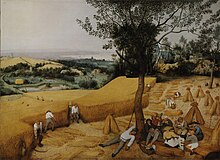
Maize and cassava were introduced from Brazil into Africa by Portuguese traders in the 16th century,[168] becoming staple foods, replacing native African crops.[169] After its introduction from South America to Spain in the late 1500s, the potato became a staple crop throughout Europe by the late 1700s. The potato allowed farmers to produce more food, and initially added variety to the European diet. The increased supply of food reduced disease, increased births and reduced mortality, causing a population boom throughout the British Empire, the US and Europe.[170] The introduction of the potato also brought about the first intensive use of fertilizer, in the form of guano imported to Europe from Peru, and the first artificial pesticide, in the form of an arsenic compound used to fight Colorado potato beetles. Before the adoption of the potato as a major crop, the dependence on grain had caused repetitive regional and national famines when the crops failed, including 17 major famines in England between 1523 and 1623. The resulting dependence on the potato however caused the European Potato Failure, a disastrous crop failure from disease that resulted in widespread famine and the death of over one million people in Ireland alone.[171]
Modern agriculture
British agricultural revolution

Between the 17th century and the mid-19th century, Britain saw a large increase in agricultural productivity and net output. New agricultural practices like enclosure, mechanization, four-field crop rotation to maintain soil nutrients, and selective breeding enabled an unprecedented population growth to 5.7 million in 1750, freeing up a significant percentage of the workforce, and thereby helped drive the Industrial Revolution. The productivity of wheat went up from 19 US bushels (670 L; 150 US dry gal; 150 imp gal) per acre in 1720 to around 30 US bushels (1,100 L; 240 US dry gal; 230 imp gal) by 1840, marking a major turning point in history.[172]
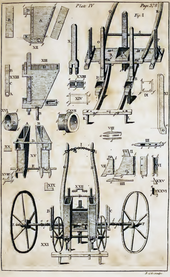
Advice on more productive techniques for farming began to appear in England in the mid-17th century, from writers such as Samuel Hartlib, Walter Blith and others.[173] The main problem in sustaining agriculture in one place for a long time was the depletion of nutrients, most importantly nitrogen levels, in the soil. To allow the soil to regenerate, productive land was often let fallow and, in some places, crop rotation was used. The Dutch four-field rotation system was popularised by the British agriculturist Charles Townshend in the 18th century. The system (wheat, turnips, barley and clover) opened up a fodder crop and grazing crop allowing livestock to be bred year-round. The use of clover was especially important as the legume roots replenished soil nitrates.[174] The mechanisation and rationalisation of agriculture was another important factor. Robert Bakewell and Thomas Coke introduced selective breeding and initiated a process of inbreeding to maximise desirable traits from the mid 18th century, such as the New Leicester sheep. Machines were invented to improve the efficiency of various agricultural operation, such as Jethro Tull's seed drill of 1701 that mechanised seeding at the correct depth and spacing and Andrew Meikle's threshing machine of 1784. Ploughs were steadily improved, from Joseph Foljambe's Rotherham iron plough in 1730[175] to James Small's improved "Scots Plough" metal in 1763. In 1789 Ransomes, Sims & Jefferies was producing 86 plough models for different soils.[176] Powered farm machinery began with Richard Trevithick's stationary steam engine, used to drive a threshing machine, in 1812.[177] Mechanisation spread to additional farm uses throughout the 19th century. The first petrol-driven tractor was built in America by John Froelich in 1892.[178]
John Bennet Lawes began the scientific investigation of fertilization at the Rothamsted Experimental Station in 1843. He investigated the impact of inorganic and organic fertilizers on crop yield and founded one of the first artificial fertilizer manufacturing factories in 1842. Fertilizer, in the shape of sodium nitrate deposits in Chile, was imported to Britain by John Thomas North as well as guano (birds droppings). The first commercial process for fertilizer production was the obtaining of phosphate from the dissolution of coprolites in sulphuric acid.[179]
20th century
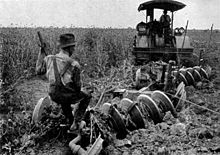
Dan Albone constructed the first commercially successful gasoline-powered general-purpose tractor in 1901, and the 1923 International Harvester Farmall tractor marked a major point in the replacement of draft animals (particularly horses) with machines. Since that time, self-propelled mechanical harvesters (combines), planters, transplanters and other equipment have been developed, further revolutionizing agriculture.[180] These inventions allowed farming tasks to be done with a speed and on a scale previously impossible, leading modern farms to output much greater volumes of high-quality produce per land unit.[181]
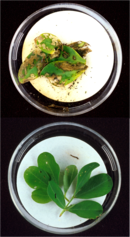
The Haber-Bosch method for synthesizing ammonium nitrate represented a major breakthrough and allowed crop yields to overcome previous constraints. It was first patented by German chemist Fritz Haber. In 1910 Carl Bosch, while working for German chemical company BASF, successfully commercialized the process and secured further patents. In the years after World War II, the use of synthetic fertilizer increased rapidly, in sync with the increasing world population.[183]
Collective farming was widely practiced in the Soviet Union, the Eastern Bloc countries, China, and Vietnam, starting in the 1930s in the Soviet Union; one result was the Soviet famine of 1932–33.[184] Another consequence occurred during the Great Leap Forward in China initiated by Mao Tse-tung that resulted in the Great Chinese Famine from 1959 to 1961 and ultimately reshaped the thinking of Deng Xiaoping.
In the past century agriculture has been characterized by increased productivity, the substitution of synthetic fertilizers and pesticides for labour, water pollution,[185] and farm subsidies.[186] Other applications of scientific research since 1950 in agriculture include gene manipulation,[187][188] hydroponics,[189] and the development of economically viable biofuels such as ethanol.[190]
The number of people involved in farming in industrial countries fell radically from 24 percent of the American population to 1.5 percent in 2002. The number of farms also decreased, and their ownership became more concentrated; for example, between 1967 and 2002, one million pig farms in America consolidated into 114,000, with 80 percent of the production on factory farms.[191] According to the Worldwatch Institute, 74 percent of the world's poultry, 43 percent of beef, and 68 percent of eggs are produced this way.[191][192]
Famines however continued to sweep the globe through the 20th century. Through the effects of climatic events, government policy, war and crop failure, millions of people died in each of at least ten famines between the 1920s and the 1990s.[193]
Green Revolution
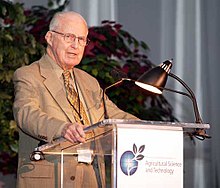
The Green Revolution was a series of research, development, and technology transfer initiatives, between the 1940s and the late 1970s. It increased agriculture production around the world, especially from the late 1960s. The initiatives, led by Norman Borlaug and credited with saving over a billion people from starvation, involved the development of high-yielding varieties of cereal grains, expansion of irrigation infrastructure, modernization of management techniques, distribution of hybridized seeds, synthetic fertilizers, and pesticides to farmers.[194]
Synthetic nitrogen, along with mined rock phosphate, pesticides and mechanization, have greatly increased crop yields in the early 20th century. Increased supply of grains has led to cheaper livestock as well. Further, global yield increases were experienced later in the 20th century when high-yield varieties of common staple grains such as rice, wheat, and corn were introduced as a part of the Green Revolution. The Green Revolution exported the technologies (including pesticides and synthetic nitrogen) of the developed world to the developing world. Thomas Malthus famously predicted that the Earth would not be able to support its growing population, but technologies such as the Green Revolution have allowed the world to produce a surplus of food.[195]
Although the Green Revolution at first significantly increased rice yields in Asia, yield then levelled off. The genetic "yield potential" has increased for wheat, but the yield potential for rice has not increased since 1966, and the yield potential for maize has "barely increased in 35 years". It takes only a decade or two for herbicide-resistant weeds to emerge, and insects become resistant to insecticides within about a decade, delayed somewhat by crop rotation.[196]
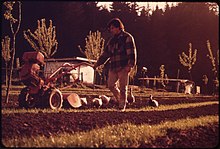
Organic agriculture
For most of its history, agriculture has been organic, without synthetic fertilisers or pesticides, and without GMOs. With the advent of chemical agriculture, Rudolf Steiner called for farming without synthetic pesticides, and his Agriculture Course of 1924 laid the foundation for biodynamic agriculture.[197] Lord Northbourne developed these ideas and presented his manifesto of organic farming in 1940. This became a worldwide movement, and organic farming is now practiced in many countries.[198]
See also
References
- ^ Safety and health in agriculture. International Labour Organization. 1999. pp. 77–. ISBN 978-92-2-111517-5. Retrieved 13 September 2010.
- ^ Chantrell, Glynnis, ed. (2002). The Oxford Dictionary of Word Histories. Oxford University Press. p. 14. ISBN 0-19-863121-9.
- ^ Ulrich G. Mueller, Nicole M. Gerardo, Duur K. Aanen, Diana L. Six, and Ted R. Schultz (December 2005). "The Evolution of Agriculture in Insects". Annual Review of Ecology, Evolution, and Systematics. 36: 563–595. doi:10.1146/annurev.ecolsys.36.102003.152626.
{{cite journal}}: CS1 maint: multiple names: authors list (link) - ^ a b "Definition of Agriculture". State of Maine. Retrieved 6 May 2013.
- ^ Committee on Forestry Research, National Research Council (1990). Forestry Research: A Mandate for Change. National Academies Press. pp. 15–16. ISBN 0-309-04248-8.
- ^ Budowski, Gerardo (1982). "Applicability of agro-forestry systems". In MacDonald, L.H. (ed.). Agro-forestry in the African Humid Tropics. United Nations University. ISBN 92-808-0364-6.
- ^ a b c "The Development of Agriculture". National Geographic. 8 July 2022. Archived from the original on 30 January 2023. Retrieved 30 January 2023.
- ^ a b Mercader, J. (December 2009). "Mozambican grass seed consumption during the Middle Stone Age". Science. 326 (5960): 1680–1683. Bibcode:2009Sci...326.1680M. doi:10.1126/science.1173966. PMID 20019285. S2CID 44865552.
- ^ Snir, Ainit (2015). "The Origin of Cultivation and Proto-Weeds, Long before Neolithic Farming". PLOS ONE. 10 (7): e0131422. Bibcode:2015PLoSO..1031422S. doi:10.1371/journal.pone.0131422. PMC 4511808. PMID 26200895.
- ^ Zeder, Melinda (October 2011). "The Origins of Agriculture in the Near East". Current Anthropology. 52 (S4): 221–235. doi:10.1086/659307. JSTOR 10.1086/659307. S2CID 8202907.
- ^ Hirst, Kris (June 2019). "Domestication History of Rye". ThoughtCo. Retrieved 18 April 2020.
- ^ Seabra, Luís; Teira-Brión, Andrés; López-Dóriga, Inés; Martín-Seijo, María; Almeida, Rubim; Tereso, João Pedro (10 May 2023). "The introduction and spread of rye (Secale cereale) in the Iberian Peninsula". PLOS ONE. 18 (5): e0284222. Bibcode:2023PLoSO..1884222S. doi:10.1371/journal.pone.0284222. PMC 10171662. PMID 37163473.
- ^ a b c Molina, J.; Sikora, M.; Garud, N.; Flowers, J. M.; Rubinstein, S.; Reynolds, A.; Huang, P.; Jackson, S.; Schaal, B. A.; Bustamante, C. D.; Boyko, A. R.; Purugganan, M. D. (2011). "Molecular evidence for a single evolutionary origin of domesticated rice". Proceedings of the National Academy of Sciences. 108 (20): 8351–6. Bibcode:2011PNAS..108.8351M. doi:10.1073/pnas.1104686108. PMC 3101000. PMID 21536870.
- ^ a b Choi, Jae Young; Zaidem, Maricris; Gutaker, Rafal; Dorph, Katherine; Singh, Rakesh Kumar; Purugganan, Michael D. (7 March 2019). "The complex geography of domestication of the African rice Oryza glaberrima". PLOS Genetics. 15 (3): e1007414. doi:10.1371/journal.pgen.1007414. ISSN 1553-7404. PMC 6424484. PMID 30845217.
- ^ a b Cubry, Philippe; Tranchant-Dubreuil, Christine; Thuillet, Anne-Céline; Monat, Cécile; Ndjiondjop, Marie-Noelle; Labadie, Karine; Cruaud, Corinne; Engelen, Stefan; Scarcelli, Nora; Rhoné, Bénédicte; Burgarella, Concetta (23 July 2018). "The Rise and Fall of African Rice Cultivation Revealed by Analysis of 246 New Genomes". Current Biology. 28 (14): 2274–2282.e6. doi:10.1016/j.cub.2018.05.066. ISSN 0960-9822. PMID 29983312. S2CID 51600014.
- ^ Winchell, Frank; Brass, Michael; Manzo, Andrea; Beldados, Alemseged; Perna, Valentina; Murphy, Charlene; Stevens, Chris; Fuller, Dorian Q. (2018). "On the Origins and Dissemination of Domesticated Sorghum and Pearl Millet across Africa and into India: a View from the Butana Group of the Far Eastern Sahel". The African Archaeological Review. 35 (4): 483–505. doi:10.1007/s10437-018-9314-2. ISSN 0263-0338. PMC 6394749. PMID 30880862.
- ^ Manning, Katie; Pelling, Ruth; Higham, Tom; Schwenniger, Jean-Luc; Fuller, Dorian Q. (1 February 2011). "4500-Year old domesticated pearl millet (Pennisetum glaucum) from the Tilemsi Valley, Mali: new insights into an alternative cereal domestication pathway". Journal of Archaeological Science. 38 (2): 312–322. Bibcode:2011JArSc..38..312M. doi:10.1016/j.jas.2010.09.007. ISSN 0305-4403.
- ^ Scarcelli, Nora; Cubry, Philippe; Akakpo, Roland; Thuillet, Anne-Céline; Obidiegwu, Jude; Baco, Mohamed N.; Otoo, Emmanuel; Sonké, Bonaventure; Dansi, Alexandre; Djedatin, Gustave; Mariac, Cédric (3 May 2019). "Yam genomics supports West Africa as a major cradle of crop domestication". Science Advances. 5 (5): eaaw1947. Bibcode:2019SciA....5.1947S. doi:10.1126/sciadv.aaw1947. ISSN 2375-2548. PMC 6527260. PMID 31114806.
- ^ Herniter, Ira A.; Muñoz-Amatriaín, María; Close, Timothy J. (December 2020). "Genetic, textual, and archeological evidence of the historical global spread of cowpea ( Vigna unguiculata [L.] Walp.)". Legume Science. 2 (4). doi:10.1002/leg3.57. ISSN 2639-6181. S2CID 220516241.
- ^ Edward, Sue B. (1991), Hawkes, J. G.; Engels, J. M. M.; Worede, M. (eds.), "Crops with wild relatives found in Ethiopia", Plant Genetic Resources of Ethiopia, Cambridge: Cambridge University Press, pp. 42–74, ISBN 978-0-521-38456-8, retrieved 9 August 2022
- ^ "Finger Millet". Crop Wild Relatives. Retrieved 9 August 2022.
- ^ "Plant studies show where Africa's early farmers tamed some of the continent's key crops". science.org. Retrieved 9 August 2022.
- ^ "Why It's Difficult to Chart Banana History". ThoughtCo. Retrieved 11 August 2022.
- ^ "Early Africans Went Bananas". science.org. Retrieved 11 August 2022.
- ^ Shen, Quan-Kuan; Peng, Min-Sheng; Adeola, Adeniyi C; Kui, Ling; et al. (8 June 2021). "Genomic Analyses Unveil Helmeted Guinea Fowl ( Numida meleagris ) Domestication in West Africa". Genome Biology and Evolution. 13 (6). doi:10.1093/gbe/evab090. PMC 8214406. PMID 34009300.
- ^ Pitt, Daniel; Sevane, Natalia; Nicolazzi, Ezequiel L.; MacHugh, David E.; Park, Stephen D. E.; Colli, Licia; Martinez, Rodrigo; Bruford, Michael W.; Orozco-terWengel, Pablo (January 2019). "Domestication of cattle: Two or three events?". Evolutionary Applications. 12 (1): 123–136. Bibcode:2019EvApp..12..123P. doi:10.1111/eva.12674. ISSN 1752-4571. PMC 6304694. PMID 30622640.
- ^ Mwai, Okeyo; Hanotte, Olivier; Kwon, Young-Jun; Cho, Seoae (11 June 2015). "- Invited Review - African Indigenous Cattle: Unique Genetic Resources in a Rapidly Changing World". Asian-Australasian Journal of Animal Sciences. 28 (7): 911–921. doi:10.5713/ajas.15.0002R. ISSN 1011-2367. PMC 4478499. PMID 26104394.
- ^ World Cotton Production, Yara North America
- ^ National Heritage Places – Budj Bim National Heritage Landscape". Australian Government. Dept of the Environment and Energy. 20 July 2004. Retrieved 30 January 2020. See also attached documents: National Heritage List Location and Boundary Map, and Government Gazette, 20 July 2004.
- ^ a b Gammage, Bill (October 2011). The Biggest Estate on Earth: How Aborigines made Australia. Allen & Unwin. pp. 281–304. ISBN 978-1-74237-748-3.
- ^ a b c "Indigenous Australians 'farmed bananas 2,000 years ago'". BBC News. 12 August 2020.
- ^ Stromberg, Joseph (February 2013). "Classical gas". Smithsonian. 43 (10): 18. Archived from the original on 15 October 2013. Retrieved 27 August 2013.
- ^ Hillman, G.C. (1996) "Late Pleistocene changes in wild plant-foods available to hunter-gatherers of the northern Fertile Crescent: Possible preludes to cereal cultivation". In D.R. Harris (ed.) The Origins and Spread of Agriculture and Pastoralism in Eurasia, UCL Books, London, pp. 159–203; Sato, Y. (2003) "Origin of rice cultivation in the Yangtze River basin". In Y. Yasuda (ed.) The Origins of Pottery and Agriculture, Roli Books, New Delhi, p. 196
- ^ a b Gerritsen, R. (2008). Australia and the Origins of Agriculture. Archaeopress. pp. 29–30.
- ^ "Climate". National Climate Data Center. Retrieved 1 December 2013.
- ^ a b c Gammage, Bill (October 2011). The Biggest Estate on Earth: How Aborigines made Australia. Allen & Unwin. ISBN 978-1-74237-748-3.
- ^ Douglas John McConnell (2003). The Forest Farms of Kandy: And Other Gardens of Complete Design. Ashgate. p. 1. ISBN 978-0-7546-0958-2.
- ^ McConnell, Douglas John (1992). The forest-garden farms of Kandy, Sri Lanka. Food & Agriculture Org. p. 1. ISBN 978-92-5-102898-8.
- ^ Allaby, Robin G.; Fuller, Dorian Q.; Brown, Terence A. (2008). "The genetic expectations of a protracted model for the origins of domesticated crops". Proceedings of the National Academy of Sciences. 105 (37): 13982–13986. Bibcode:2008PNAS..10513982A. doi:10.1073/pnas.0803780105. PMC 2544565. PMID 18768818.
- ^ Larson, G.; Piperno, D.R.; Allaby, R.G.; Purugganan, M.D.; Andersson, L.; Arroyo-Kalin, M.; Barton, L.; Climer Vigueira, C.; Denham, T.; Dobney, K.; Doust, A.N.; Gepts, P.; Gilbert, M.T.P.; Gremillion, K.J.; Lucas, L.; Lukens, L.; Marshall, F.B.; Olsen, K.M.; Pires, J.C.; Richerson, P.J.; Rubio De Casas, R.; Sanjur, O.I.; Thomas, M.G.; Fuller, D.Q. (2014). "Current perspectives and the future of domestication studies". Proceedings of the National Academy of Sciences. 111 (17): 6139–46. Bibcode:2014PNAS..111.6139L. doi:10.1073/pnas.1323964111. PMC 4035915. PMID 24757054.
- ^ Larson, Greger; Dobney, Keith; Albarella, Umberto; Fang, Meiying; Matisoo-Smith, Elizabeth; Robins, Judith; Lowden, Stewart; Finlayson, Heather; Brand, Tina (11 March 2005). "Worldwide Phylogeography of Wild Boar Reveals Multiple Centers of Pig Domestication". Science. 307 (5715): 1618–1621. Bibcode:2005Sci...307.1618L. doi:10.1126/science.1106927. PMID 15761152. S2CID 39923483.
- ^ Larson, Greger; Albarella, Umberto; Dobney, Keith; Rowley-Conwy, Peter; Schibler, Jörg; Tresset, Anne; Vigne, Jean-Denis; Edwards, Ceiridwen J.; Schlumbaum, Angela (25 September 2007). "Ancient DNA, pig domestication, and the spread of the Neolithic into Europe". Proceedings of the National Academy of Sciences. 104 (39): 15276–15281. Bibcode:2007PNAS..10415276L. doi:10.1073/pnas.0703411104. PMC 1976408. PMID 17855556.
- ^ Ensminger, M.E.; Parker, R.O. (1986). Sheep and Goat Science (Fifth ed.). Interstate Printers and Publishers. ISBN 978-0-8134-2464-4.
- ^ McTavish, E.J.; Decker, J.E.; Schnabel, R.D.; Taylor, J.F.; Hillis, D.M. (2013). "New World cattle show ancestry from multiple independent domestication events". PNAS. 110 (15): 1398–406. Bibcode:2013PNAS..110E1398M. doi:10.1073/pnas.1303367110. PMC 3625352. PMID 23530234.
- ^ Sapir-Hen, Lidar; Ben-Yosef, Erez (2013). "The Introduction of Domestic Camels to the Southern Levant: Evidence from the Aravah Valley" (PDF). Tel Aviv. 40 (2): 277–285. doi:10.1179/033443513x13753505864089. S2CID 44282748.
- ^ Ladizinsky, G. (1998). Plant Evolution under Domestication. Kluwer. ISBN 978-0-412-82210-0.
- ^ Kislev, M. E. (2006). "Early Domesticated Fig in the Jordan Valley". Science. 312 (5778): 1372–1374. Bibcode:2006Sci...312.1372K. doi:10.1126/science.1125910. PMID 16741119. S2CID 42150441.
- ^ Lev-Yadun, S. (2006). "Comment on "Early Domesticated Fig in the Jordan Valley"". Science. 314 (5806): 1683a. Bibcode:2006Sci...314.1683L. doi:10.1126/science.1132636. PMID 17170278.
- ^ Hillman, Gordon (1978). "On the Origins of Domestic rye: Secale Cereale: The Finds from Aceramic Can Hasan III in Turkey". Anatolian Studies. 28: 157–174. doi:10.2307/3642748. JSTOR 3642748. S2CID 85225244. – via JSTOR (subscription required)
- ^ Zohary, Daniel; Hopf, Maria; Weiss, Ehud (2012). Domestication of Plants in the Old World: The Origin and Spread of Domesticated Plants in Southwest Asia, Europe, and the Mediterranean Basin. Oxford: Oxford University Press. p. 62. ISBN 978-0-19-954906-1 – via Google Books.
- ^ Hillman, Gordon; Hedges, Robert; Moore, Andrew; Colledge, Susan; Pettitt, Paul (2001). "New evidence of Lateglacial cereal cultivation at Abu Hureyra on the Euphrates". The Holocene. 11 (4): 383–393. Bibcode:2001Holoc..11..383H. doi:10.1191/095968301678302823. S2CID 84930632.
- ^ Colledge, Sue; Conolly, James (2010). "Reassessing the evidence for the cultivation of wild crops during the Younger Dryas at Tell Abu Hureyra, Syria". Environmental Archaeology. 15 (2): 124–138. Bibcode:2010EnvAr..15..124C. doi:10.1179/146141010X12640787648504. S2CID 129087203.
- ^ Dolores, R.; Piperno, Anthony J.; Ranere, Irene Holst; Iriarte, Jose; Dickau, Ruth (2009). "Starch grain and phytolith evidence for early ninth millennium B.P. maize from the Central Balsas River Valley, Mexico". PNAS. 106 (13): 5019–5024. Bibcode:2009PNAS..106.5019P. doi:10.1073/pnas.0812525106. PMC 2664021. PMID 19307570.
- ^ Smith, A.F. (1994). The Tomato in America: Early History, Culture, and Cookery. University of South Carolina Press. p. 13. ISBN 978-1-57003-000-0.
- ^ Denham, T.P. (2003). "Origins of Agriculture at Kuk Swamp in the Highlands of New Guinea" (PDF). Science. 301 (5630): 189–193. doi:10.1126/science.1085255. PMID 12817084. S2CID 10644185.
- ^ Nelson, S.C.; Ploetz, R.C.; Kepler, A.K. (2006). "Musa species (bananas and plantains)" (PDF). In Elevitch, C.R. (ed.). Species Profiles for Pacific Island Agroforestry. Hōlualoa, Hawaiʻi: Permanent Agriculture Resources.
- ^ Denham, T.P.; Haberle, S.G.; Lentfer, C.; Fullagar, R.; Field, J.; Therin, M.; Porch, N.; Winsborough, B. (2003). "Origins of Agriculture at Kuk Swamp in the Highlands of New Guinea" (PDF). Science. 301 (5630): 189–193. doi:10.1126/science.1085255. PMID 12817084. S2CID 10644185.
- ^ Roffet-Salque, Mélanie; Regert, Martine; Evershed, Richard P.; et al. (2015). "Widespread exploitation of the honeybee by early Neolithic farmers". Nature. 527 (7577): 226–230. Bibcode:2015Natur.527..226R. doi:10.1038/nature15757. hdl:10379/13692. PMID 26560301. S2CID 205246432.
- ^ "Southern Europe, 8000–2000 B.C. Timeline of Art History". The Metropolitan Museum of Art. Archived from the original on 26 January 2007. Retrieved 16 July 2011.
- ^ "Ceide Fields Visitor Centre, Ballycastle, County Mayo, West of Ireland". Museums of Mayo. Archived from the original on 22 July 2011. Retrieved 16 July 2011.
- ^ "The Céide Fields and North West Mayo Boglands". UNESCO World Heritage Centre. Archived from the original on 17 October 2011. Retrieved 16 July 2011.
- ^ Anthony, David W. (2007). The Horse, the Wheel, and Language: How Bronze-Age Riders from the Eurasian Steppes Shaped the Modern World. Princeton University Press.
- ^ Vergara, Daniela (2 December 2014). "Cannabis: Marijuana, hemp and its cultural history". Cannabis Genomics. Archived from the original on 9 April 2016. Retrieved 20 June 2016.
- ^ a b He, Keyang; Lu, Houyuan; Zhang, Jianping; Wang, Can; Huan, Xiujia (7 June 2017). "Prehistoric evolution of the dualistic structure mixed rice and millet farming in China". The Holocene. 27 (12): 1885–1898. Bibcode:2017Holoc..27.1885H. doi:10.1177/0959683617708455. S2CID 133660098.
- ^ Lu, H.; Zhang, J.; Liu, K.B.; Wu, N.; Li, Y.; Zhou, K.; Ye, M.; Zhang, T.; et al. (2009). "Earliest domestication of common millet (Panicum miliaceum) in East Asia extended to 10,000 years ago". Proceedings of the National Academy of Sciences of the United States of America. 106 (18): 7367–7372. Bibcode:2009PNAS..106.7367L. doi:10.1073/pnas.0900158106. PMC 2678631. PMID 19383791.
- ^ Chambers, Geoff (2013). "Genetics and the Origins of the Polynesians". eLS. John Wiley & Sons, Inc. doi:10.1002/9780470015902.a0020808.pub2. ISBN 978-0-470-01617-6.
- ^ a b Bellwood, Peter (9 December 2011). "The Checkered Prehistory of Rice Movement Southwards as a Domesticated Cereal—from the Yangzi to the Equator" (PDF). Rice. 4 (3–4): 93–103. Bibcode:2011Rice....4...93B. doi:10.1007/s12284-011-9068-9. S2CID 44675525.
- ^ Hsieh, Jaw-shu; Hsing, Yue-ie Caroline; Hsu, Tze-fu; Li, Paul Jen-kuei; Li, Kuang-ti; Tsang, Cheng-hwa (24 December 2011). "Studies on Ancient Rice—Where Botanists, Agronomists, Archeologists, Linguists, and Ethnologists Meet". Rice. 4 (3–4): 178–183. Bibcode:2011Rice....4..178H. doi:10.1007/s12284-011-9075-x.
- ^ Gilboa, Ayelet; Namdar, Dvory (9 February 2016). "On the Beginnings of South Asian Spice Trade with the Mediterranean Region: A Review". Radiocarbon. 57 (2): 265–283. doi:10.2458/azu_rc.57.18562. S2CID 55719842.
- ^ Zumbroich, Thomas J. (2007–2008). "The origin and diffusion of betel chewing: a synthesis of evidence from South Asia, Southeast Asia and beyond". eJournal of Indian Medicine. 1: 87–140.
- ^ Mahdi, Waruno (1999). "The Dispersal of Austronesian boat forms in the Indian Ocean". In Blench, Roger; Spriggs, Matthew (eds.). Archaeology and Language III: Artefacts languages, and texts. One World Archaeology. Vol. 34. Routledge. pp. 144–179. ISBN 978-0-415-10054-0.
- ^ Beaujard, Philippe (August 2011). "The first migrants to Madagascar and their introduction of plants: linguistic and ethnological evidence" (PDF). Azania: Archaeological Research in Africa. 46 (2): 169–189. doi:10.1080/0067270X.2011.580142. S2CID 55763047.
- ^ Walter, Annie; Lebot, Vincent (2007). Gardens of Oceania. IRD Éditions-CIRAD. ISBN 978-1-86320-470-5.
- ^ a b Winchell, Frank (October 2017). "Evidence for Sorghum Domestication in Fourth Millennium BC Eastern Sudan: Spikelet Morphology from Ceramic Impressions of the Butana Group" (PDF). Current Anthropology. 58 (5): 673–683. doi:10.1086/693898. S2CID 149402650.
- ^ a b Manning, Katie (February 2011). "4500-Year old domesticated pearl millet (Pennisetum glaucum) from the Tilemsi Valley, Mali: new insights into an alternative cereal domestication pathway". Journal of Archaeological Science. 38 (2): 312–322. Bibcode:2011JArSc..38..312M. doi:10.1016/j.jas.2010.09.007 – via Elsevier Science Direct.
- ^ a b Carney, Judith (2011). "Food and the African Past". In the Shadow of Slavery: Africa's Botanical Legacy in the Atlantic World. University of California Press. p. 24. ISBN 978-0-520-94953-9.
- ^ a b c Murphy, Denis (2011). Plants, Biotechnology and Agriculture. CABI. pp. 153–. ISBN 978-1-84593-913-7.
- ^ Barker, Graeme (2009). The Agricultural Revolution in Prehistory: Why Did Foragers Become Farmers?. Oxford University Press. pp. 159–161. ISBN 978-0-19-955995-4.
- ^ Anderson, David; Goudie, Andrew; Parker, Adrian (2013). Global Environments Through the Quaternary: Exploring Environmental Change. Oxford University Press. p. 283. ISBN 978-0-19-969726-7.
- ^ "Farming". British Museum. Archived from the original on 16 June 2016. Retrieved 15 June 2016.
- ^ Tannahill, Reay (1968). The fine art of food. Folio Society.
- ^ a b Janick, Jules (2002). "Ancient Egyptian Agriculture and the Origins of Horticulture" (PDF). Acta Hort. 583 (582): 23–39. doi:10.17660/ActaHortic.2002.582.1.
- ^ Kees, Herman (1961). Ancient Egypt: A Cultural Topography. University of Chicago Press. ISBN 978-0-226-42914-4.
- ^ Jack, Harlan (2006). "Indigenous African Agriculture" In the origins of agriculture: an international perspective ([New] ed.). Tuscaloosa: University of Alabama Press. pp. 59–71. ISBN 0-8173-5349-6.
- ^ a b Gupta, Anil K (10 July 2004). "Origin of agriculture and domestication of plants and animals linked to early Holocene climate amelioration". Current Science. 87 (1). Indian Academy of Sciences: 58–59.
- ^ Baber, Zaheer (1996). The Science of Empire: Scientific Knowledge, Civilization, and Colonial Rule in India. State University of New York Press. p. 19. ISBN 978-0-7914-2919-8.
- ^ a b c Harris, David R.; Gosden, C. (1996). The Origins and Spread of Agriculture and Pastoralism in Eurasia: Crops, Fields, Flocks And Herds. Routledge. p. 385. ISBN 978-1-85728-538-3.
- ^ Wright, Rita P (2009). The Ancient Indus: Urbanism, Economy, and Society. Cambridge University Press. pp. 44, 51. ISBN 978-0-521-57652-9.
- ^ Possehl, Gregory L. (1996). Mehrgarh in Oxford Companion to Archaeology, edited by Brian Fagan. Oxford University Press.
- ^ Stein, Burton (1998). A History of India. Blackwell Publishing. 47. ISBN 0-631-20546-2.
- ^ a b Rodda & Ubertini (2004). The Basis of Civilization – Water Science?. International Association of Hydrological Science. p. 279. ISBN 978-1-901502-57-2.
- ^ Lal, R. (2001). "Thematic evolution of ISTRO: transition in scientific issues and research focus from 1955 to 2000". Soil and Tillage Research. 61 (1–2): 3–12 [3]. Bibcode:2001STilR..61....3L. doi:10.1016/S0167-1987(01)00184-2.
- ^ Needham, Joseph (1986). Science and Civilization in China: Volume 6, Part 2. Taipei: Caves Books Ltd. pp. 55–56.
- ^ a b Needham, Volume 6, Part 2, 56.
- ^ Needham, Volume 6, Part 2, 57.
- ^ Needham, Joseph (1986). Science and Civilization in China: Volume 4, Physics and Physical Technology, Part 2, Mechanical Engineering. Taipei: Caves Books, Ltd. p. 184
- ^ Needham, Volume 4, Part 2, 89, 110.
- ^ Needham, Volume 4, Part 2, 33.
- ^ Needham, Volume 4, Part 2, 110.
- ^ Robert Greenberger, The Technology of Ancient China, Rosen Publishing Group, 2006, pp. 11–12.
- ^ Wang Zhongshu, trans. by K.C. Chang and Collaborators, Han Civilization (New Haven and London: Yale University Press, 1982).
- ^ Glick, Thomas F. (2005). Medieval Science, Technology And Medicine: An Encyclopedia. Volume 11 of The Routledge Encyclopedias of the Middle Ages Series. Psychology Press. p. 270. ISBN 978-0-415-96930-7.
- ^ Huang, Xuehui; Kurata, Nori; Wei, Xinghua; Wang, Zi-Xuan; Wang, Ahong; Zhao, Qiang; Zhao, Yan; Liu, Kunyan; et al. (2012). "A map of rice genome variation reveals the origin of cultivated rice". Nature. 490 (7421): 497–501. Bibcode:2012Natur.490..497H. doi:10.1038/nature11532. PMC 7518720. PMID 23034647.
- ^ Koester, Helmut (1995), History, Culture, and Religion of the Hellenistic Age, 2nd edition, New York: Walter de Gruyter, ISBN 3-11-014693-2, pp. 76–77.
- ^ Helmut Koester (1995), History, Culture, and Religion of the Hellenistic Age, 2nd edition, New York: Walter de Gruyter, ISBN 3-11-014693-2, p. 77.
- ^ White, K. D. (1970), Roman Farming (Cornell University Press)
- ^ Diamond, Jared (1999). Guns, Germs, and Steel (Paperback ed.). New York: W.W. Norton. pp. 123–128, 134–142. ISBN 0-393-31755-2.
- ^ a b Sempat Assadourian, Carlos (1992). "The Colonial Economy; The Transfer of the European System of Production to New Spain and Peru". Journal of Latin American Studies. 24 (Quincentenary Supplement): 62. JSTOR 156945.
- ^ Hill, Christina Gish (24 November 2020). "Returning Corn, Beans, and Squash to Native American Farms". JSTOR Daily. JSTOR. Retrieved 9 July 2021.
- ^ Ensminger, Marion Eugene; Ensminger, Audrey H. (1994). Food & Nutrition Encyclopedia. London: CRC-Press. p. 1104.
- ^ Zarrillo, S.; Pearsall, D. M.; Tisdale, M. A.; Quon, D. J. (2008). "Directly dated starch residues document early formative maize (Zea mays L.) in tropical Ecuador". Proceedings of the National Academy of Sciences of the United States of America. 105 (13): 5006–5011. Bibcode:2008PNAS..105.5006Z. doi:10.1073/pnas.0800894105. PMC 2278185. PMID 18362336.
- ^ Piperno, Dolores R. (2011). "The Origin of Plant Cultivation and Domestication in the New World Tropics: Pattern, Process, and New Developments". Current Anthropology. 52 (S-4): S453–S470. doi:10.1086/659998. S2CID 83061925.
- ^ Larson, Gregor (29 April 2014). "Current Perspectives and the Future of Domestication Studies". Proceedings of the National Academy of Sciences. 111 (17): 6139–6146. Bibcode:2014PNAS..111.6139L. doi:10.1073/pnas.1323964111. PMC 4035915. PMID 24757054.
- ^ Spooner, David M.; McLean, Karen; Ramsay, Gavin; Waugh, Robbie; Bryan, Glenn J. (2005). "A single domestication for potato based on multilocus amplified fragment length polymorphism genotyping". PNAS. 102 (41): 14694–14699. Bibcode:2005PNAS..10214694S. doi:10.1073/pnas.0507400102. PMC 1253605. PMID 16203994.
- ^ Office of International Affairs (1989). Lost Crops of the Incas: Little-Known Plants of the Andes with Promise for Worldwide Cultivation. p. 92. doi:10.17226/1398. ISBN 978-0-309-04264-2 – via nap.edu.
- ^ John Michael Francis (2005). Iberia and the Americas. ABC-CLIO. ISBN 978-1-85109-426-4.
- ^ Rajpal, Vijay Rani (2016). Gene Pool Diversity and Crop Improvement, Volume 1. Springer. p. 117. ISBN 978-3-319-27096-8. Retrieved 9 April 2016.
- ^ Broudy, Eric (1979). The Book of Looms: A History of the Handloom from Ancient Times to the Present. UPNE. p. 81. ISBN 978-0-87451-649-4.
- ^ Rischkowsky, Barbara; Pilling, Dafydd (2007). The State of the World's Animal Genetic Resources for Food and Agriculture. Food & Agriculture Organization. p. 10. ISBN 978-92-5-105762-9.
- ^ Mumford, Jeremy Ravi (2012). Vertical Empire. Durham, NC: Duke University Press. pp. 15, 27. ISBN 978-0-8223-5310-2.
- ^ Isendahl, Christian (December 2011). "The Domestication and Early Spread of Manioc". Latin American Antiquity. 22 (4): 464. doi:10.7183/1045-6635.22.4.452. JSTOR 23072569. S2CID 161372308.
- ^ Bird, Junius (1946). "The Alacaluf". In Steward, Julian H. (ed.). Handbook of South American Indians. Bulletin 143. Vol. I. –Bureau of American Ethnology. pp. 55–79.
- ^ Contreras, Andrés; Ciampi, Luigi; Padulosi, Stefano; Spooner, David M. (1993). "Potato germplasm collecting expedition to the Guaitecas and Chonos Archipelagos, Chile, 1990". Potato Research. 36 (4): 309–316. doi:10.1007/BF02361797. S2CID 6759459. Archived from the original on 1 August 2020. Retrieved 11 January 2019.
- ^ Johannessen, S.; Hastorf, C.A. (eds.). Corn and Culture in the Prehistoric New World. Westview Press.
- ^ Speller, Camilla F.; et al. (2010). "Ancient mitochondrial DNA analysis reveals complexity of indigenous North American turkey domestication". PNAS. 107 (7): 2807–2812. Bibcode:2010PNAS..107.2807S. doi:10.1073/pnas.0909724107. PMC 2840336. PMID 20133614.
- ^ Mascarelli, Amanda (5 November 2010). "Mayans converted wetlands to farmland". Nature. doi:10.1038/news.2010.587.
- ^ Morgan, John (6 November 2013). "Invisible Artifacts: Uncovering Secrets of Ancient Maya Agriculture with Modern Soil Science". Soil Horizons. 53 (6): 3. doi:10.2136/sh2012-53-6-lf.
- ^ Heiser, Carl B. Jr. (1992). "On possible sources of the tobacco of prehistoric Eastern North America". Current Anthropology. 33: 54–56. doi:10.1086/204032. S2CID 144433864.
- ^ Prehistoric Food Production in North America, edited by Richard I. Ford. Museum of Anthropology, University of Michigan, Anthropological Papers 75.
- ^ Adair, Mary J. (1988) Prehistoric Agriculture in the Central Plains. Publications in Anthropology 16. University of Kansas, Lawrence.
- ^ Smith, Andrew (2013). The Oxford Encyclopedia of Food and Drink in America. OUP US. pp. 1–. ISBN 978-0-19-973496-2.
- ^ Hardigan, Michael A. "P0653: Domestication History of Strawberry: Population Bottlenecks and Restructuring of Genetic Diversity through Time". Pland & Animal Genome Conference XXVI January 13–17, 2018 San Diego, California. Retrieved 28 February 2018.
- ^ "Pecans at Texas A&M University". Pecankernel.tamu.edu. 18 August 2006. Archived from the original on 25 May 2010. Retrieved 3 June 2010.
- ^ The History of Concord Grapes, http://www.concordgrape.org/bodyhistory.html
- ^ Sugihara, Neil G.; Jan W. Van Wagtendonk; Shaffer, Kevin E.; Fites-Kaufman, Joann; Thode, Andrea E., eds. (2006). "17". Fire in California's Ecosystems. University of California Press. p. 417. ISBN 978-0-520-24605-8.
- ^ Blackburn, Thomas C. and Kat Anderson, ed. (1993). Before the Wilderness: Environmental Management by Native Californians. Ballena Press. ISBN 978-0-87919-126-9.
- ^ Cunningham, Laura (2010). State of Change: Forgotten Landscapes of California. Heyday. pp. 135, 173–202. ISBN 978-1-59714-136-9.
- ^ Anderson, M. Kat (2006). Tending the Wild: Native American Knowledge And the Management of California's Natural Resources. University of California Press. ISBN 978-0-520-24851-9.
- ^ Wilson, Gilbert (1917). Agriculture of the Hidatsa Indians: An Indian Interpretation. Dodo Press. pp. 25 and passim. ISBN 978-1-4099-4233-7. Archived from the original on 14 March 2016.
- ^ Landon, Amanda J. (2008). "The "How" of the Three Sisters: The Origins of Agriculture in Mesoamerica and the Human Niche". Nebraska Anthropologist. University of Nebraska-Lincoln: 110–124.
- ^ Beja-Pereira, Albano; et al. (18 June 2004). "African Origins of the Domestic Donkey". Science. 304 (1781): 1781. doi:10.1126/science.1096008. PMID 15205528. S2CID 12783335.
- ^ Roger Blench, "The history and spread of donkeys in Africa" (PDF). (235 KB)
- ^ Grigson, Caroline (1991). "An African origin for African cattle? — some archaeological evidence". The African Archaeological Review. 9 (1): 119–144. doi:10.1007/BF01117218. S2CID 162307756.
- ^ "Celebrating Nigeria's yummy yams". BBC News. 22 September 2010. Retrieved 15 November 2023.
- ^ Blench, Roger; MacDonald, Kevin C. (1999). The Origins and Development of African Livestock. London: UCL. p. 10. ISBN 978-1-84142-018-9.
- ^ Weinberg, Bennett Alan; Bealer, Bonnie K. (2001). The World of Caffeine: The Science and Culture of the World's Most Popular Drug. Psychology Press. pp. 3–4. ISBN 978-0-415-92723-9.
- ^ Dark Emu
- ^ Jones, R. (1969). "Fire-stick Farming". Australian Natural History. 16: 224.
- ^ Williams, E. (1988) Complex Hunter-Gatherers: A Late Holocene Example from Temperate Australia. British Archaeological Reports, Oxford
- ^ Lourandos, H. (1997) Continent of Hunter-Gatherers: New Perspectives in Australian Prehistory Cambridge University Press, Cambridge
- ^ Bourke, R. Michael (2009), "History of agriculture in Papua New Guinea", in Bourke, R. Michael; Harwood, Tracy (eds.), Food and Agriculture in Papua New Guinea, Australian National University Press, pp. 10–26, ISBN 978-1-921536-60-1, JSTOR j.ctt24h987.12
- ^ Jourdan, Pablo. "Medieval Horticulture/Agriculture". Ohio State University. Archived from the original on 14 April 2013. Retrieved 24 April 2013.
- ^ Janick, Jules (2008). "Islamic Influences on Western Agriculture" (PDF). Purdue University. Retrieved 23 May 2013.
- ^ White, Lynn (1967). "The Life of the Silent Majority". In Hoyt, Robert S. (ed.). Life and Thought in the Early Middle Ages. University of Minnesota Press. p. 88.
- ^ Andersen, Thomas Barnebeck; Jensen, Peter Sandholt; Skovsgaard, Christian Volmar (December 2014). "The Heavy Plough and the Agricultural Revolution in Medieval Europe" (PDF). European Historical Economics Society. Archived from the original (PDF) on 18 August 2016. Retrieved 5 April 2017.
- ^ Fox, H.S.A. (November 1986). "The Alleged Transformation from Two-Field to Three-Field Systems in Medieval England". The Economic History Review. 39 (4): 526–548. doi:10.1111/j.1468-0289.1986.tb01255.x. JSTOR 2596482.
- ^ White, Lynn Townsend (1978). Medieval Religion and Technology: Collected Essays. University of California Press. p. 143. ISBN 978-0-520-03566-9.
- ^ Newman, Paul B. (2001). Daily Life in the Middle Ages. McFarland. pp. 88–89. ISBN 978-0-7864-5052-7.
- ^ Campbell, Bruce M.S.; M. Overton (1993). "A New Perspective on Medieval and Early Modern Agriculture: Six Centuries of Norfolk Farming, c.1250-c.1850". Past and Present. 141: 38–105. doi:10.1093/past/141.1.38.
- ^ Campbell, Bruce M.S. (2000). English Seigniorial Agriculture, 1250–1450. Cambridge University Press. ISBN 978-0-521-30412-2.
- ^ Stone, David (2005). Decision-Making in Medieval Agriculture. Oxford University Press. ISBN 978-0-19-924776-9.
- ^ Langdon, John (2010). Bjork, Robert E. (ed.). The Oxford Dictionary of the Middle Ages. Oxford University Press. pp. 20–23. ISBN 978-0-19-866262-4.
- ^ Jordan, William Chester (1997). The Great Famine: Northern Europe in the Early Fourteenth Century. Princeton University Press. ISBN 978-1-4008-2213-3.
- ^ a b c Watson, Andrew M. (1974). "The Arab Agricultural Revolution and Its Diffusion, 700–1100". The Journal of Economic History. 34 (1): 8–35. doi:10.1017/s0022050700079602. S2CID 154359726.
- ^ Watson, Andrew M. (1983). Agricultural Innovation in the Early Islamic World. Cambridge University Press. ISBN 978-0-521-24711-5.
- ^ Food Journeys of a Lifetime. National Geographic Society. 2015. pp. 126–. ISBN 978-1-4262-1609-1.
- ^ Crosby, Alfred. "The Columbian Exchange". The Gilder Lehrman Institute of American History. Retrieved 11 May 2013.
- ^ Wagner, Holly. "Super-Sized Cassava Plants May Help Fight Hunger In Africa". The Ohio State University. Archived from the original on 8 December 2013. Retrieved 11 May 2013.
- ^ Wambugu, Florence; Wafula, John, eds. (2000). "Advances in Maize Streak Virus Disease Research in Eastern and Southern Africa". International Service for the Acquisition of Agri-Biotech Applications. Retrieved 16 April 2013.
- ^ Chapman, Jeff (2000). "The Impact of the Potato". History Magazine (2). Archived from the original on 11 May 2000.
- ^ Mann, Charles C. "How the Potato Changed History". Smithsonian (November 2011). Archived from the original on 2 November 2013. Retrieved 28 November 2013. Adapted from 1493: Uncovering the New World Columbus Created, by Charles C. Mann.
- ^ Snell, K.D.M. (1985). Annals of the Labouring Poor, Social Change and Agrarian England 1660–1900. Cambridge University Press. ISBN 978-0-521-24548-7. Chapter 4
- ^ Thirsk, Joan (2004). "Blith, Walter (bap. 1605, d. 1654)". Oxford Dictionary of National Biography (online ed.). Oxford University Press. doi:10.1093/ref:odnb/2655. Retrieved 2 September 2011. (Subscription or UK public library membership required.)
- ^ Harskamp, Jaap (2009). "The Low Countries and the English Agricultural Revolution". Gastronomica. 9 (3): 32–41. doi:10.1525/gfc.2009.9.3.32. JSTOR 10.1525/gfc.2009.9.3.32.
- ^ Payne, F.G. "The British Plough: Some Stages in its Development" (PDF). British Agricultural History Society. Retrieved 5 April 2017.
- ^ Barlow, Robert Stockes (2003). 300 Years of Farm Implements and Machinery 1630–1930. Krause Publications. p. 33. ISBN 978-0-87349-632-2.
- ^ Hodge, James (1973). Richard Trevithick. Shire Publications. p. 30. ISBN 978-0-85263-177-5.
- ^ Macmillan, Don; Broehl, Wayne G. The John Deere Tractor Legacy. Voyageur Press. p. 45. ISBN 978-1-61060-529-8.
- ^ "The Coprolite Industry". Cambridgeshire History. Archived from the original on 4 April 2016. Retrieved 5 April 2017.
- ^ Janick, Jules. "Agricultural Scientific Revolution: Mechanical" (PDF). Purdue University. Retrieved 24 May 2013.
- ^ Reid, John F. (2011). "The Impact of Mechanization on Agriculture". The Bridge on Agriculture and Information Technology. 41 (3).
- ^ Suszkiw, Jan (November 1999). "Tifton, Georgia: A Peanut Pest Showdown". Agricultural Research magazine. Retrieved 23 November 2008.
- ^ "A Historical Perspective". International Fertilizer Industry Association. Archived from the original on 9 March 2012. Retrieved 7 May 2013.
- ^ Iordachi, Constantin; Bauerkamper, Arnd (2014). The Collectivization of Agriculture in Communist Eastern Europe: Comparison and Entanglements. Central European University Press. p. 9. ISBN 978-615-5225-63-5.
- ^ Moss, Brian (2008). "Water Pollution by Agriculture". Phil. Trans. R. Soc. Lond. B. 363 (1491): 659–666. doi:10.1098/rstb.2007.2176. PMC 2610176. PMID 17666391.
- ^ "Title 05 – Agriculture and rural development". Archived from the original on 4 December 2013. Retrieved 16 June 2016.
- ^ James, Clive (1996). "Global Review of the Field Testing and Commercialization of Transgenic Plants: 1986 to 1995" (PDF). The International Service for the Acquisition of Agri-biotech Applications. Retrieved 17 July 2010.
- ^ Weasel, Lisa H. 2009. Food Fray. Amacom Publishing
- ^ Douglas, James S., Hydroponics, 5th ed. Oxford University Press, 1975. 1–3
- ^ "Towards Sustainable Production and Use of Resources: Assessing Biofuels" (PDF). United Nations Environment Programme. 16 October 2009. Archived from the original (PDF) on 22 November 2009. Retrieved 24 October 2009.
- ^ a b Scully, Matthew (2002). Dominion: The Power of Man, the Suffering of Animals, and the Call to Mercy. Macmillan. pp. 26, 29. ISBN 978-0-312-31973-1.
- ^ "State of the World 2006". Worldwatch Institute. 2006.
- ^ "Ten worst famines of the 20th century". Sydney Morning Herald. 15 August 2011.
- ^ Hazell, Peter B.R. (2009). The Asian Green Revolution. IFPRI Discussion Paper. International Food Policy Research Institute. GGKEY:HS2UT4LADZD.
- ^ Barrionuevo, Alexei; Bradsher, Keith (8 December 2005). "Sometimes a Bumper Crop Is Too Much of a Good Thing". The New York Times.
- ^ Tilman, D.; Cassman, K.G.; Matson, P.A.; Naylor, R.; Polasky, S. (August 2002). "Agricultural sustainability and intensive production practices" (PDF). Nature. 418 (6898): 671–677. Bibcode:2002Natur.418..671T. doi:10.1038/nature01014. PMID 12167873. S2CID 3016610. Archived from the original (PDF) on 16 July 2011. Retrieved 28 November 2013.
- ^ Paull, John (2011). "Attending the First Organic Agriculture Course: Rudolf Steiner's Agriculture Course at Koberwitz, 1924" (PDF). European Journal of Social Sciences. 21 (1): 64–70.
- ^ Paull, John (2014). "Lord Northbourne, the man who invented organic farming, a biography" (PDF). Journal of Organic Systems. 9 (1): 31–53.
Further reading
Surveys
- Civitello, Linda. Cuisine and Culture: A History of Food and People (Wiley, 2011) excerpt
- Federico, Giovanni. Feeding the World: An Economic History of Agriculture 1800–2000 (Princeton UP, 2005) highly quantitative
- Grew, Raymond. Food in Global History Archived 2011-06-04 at the Wayback Machine (1999)
- Heiser, Charles B. Seed to Civilization: The Story of Food (W.H. Freeman, 1990)
- Herr, Richard, ed. Themes in Rural History of the Western World (Iowa State UP, 1993)
- Kiple, Kenneth F., and Kriemhild Coneè Ornelas, eds. The Cambridge world history of food (2 vol Cambridge University Press, 2000) online.
- Mazoyer, Marcel, and Laurence Roudart. A History of World Agriculture: From the Neolithic Age to the Current Crisis (Monthly Review Press, 2006) Marxist perspective.
- Pilcher, Jeffrey M. Food in world history (Routledge, 2023).
- Prentice, E. Parmalee. Hunger and History: The Influence of Hunger on Human History (Harper, 1939)
- Tauger, Mark. Agriculture in World History (Routledge, 2008)
- Toussaint-Samat, Maguelonne. A history of food ( John Wiley & Sons, 2009), 800+ pp. online
- Whayne, Jeannie. The Oxford Handbook of Agricultural History (2024) excerpt; covers historiographical traditions within geographic regions across the world.
Premodern
- Bakels, C.C. The Western European Loess Belt: Agrarian History, 5300 BC – AD 1000 (Springer, 2009)
- Barker, Graeme, and Candice Goucher, eds. The Cambridge World History: Volume 2, A World with Agriculture, 12000 BCE–500 CE. (Cambridge UP, 2015)
- Bowman, Alan K. and Rogan, Eugene, eds. Agriculture in Egypt: From Pharaonic to Modern Times (Oxford UP, 1999)
- Cohen, M.N. The Food Crisis in Prehistory: Overpopulation and the Origins of Agriculture (Yale UP, 1977)
- Crummey, Donald and Stewart, C.C., eds. Modes of Production in Africa: The Precolonial Era (Sagem 1981)
- Diamond, Jared. Guns, Germs, and Steel (W.W. Norton, 1997)
- Duncan-Jones, Richard. Economy of the Roman Empire (Cambridge UP, 1982)
- Habib, Irfan. Agrarian System of Mughal India (Oxford UP, 3rd ed. 2013)
- Harris, D.R., ed. The Origins and Spread of Agriculture and Pastoralism in Eurasia, (Routledge, 1996)
- Isager, Signe and Jens Erik Skydsgaard. Ancient Greek Agriculture: An Introduction (Routledge, 1995)
- Lee, Mabel Ping-hua. The economic history of china: with special reference to agriculture (Columbia University, 1921)
- Murray, Jacqueline. The First European Agriculture (Edinburgh UP, 1970)
- Oka, H-I. Origin of Cultivated Rice (Elsevier, 2012)
- Price, T.D. and A. Gebauer, eds. Last Hunters – First Farmers: New Perspectives on the Prehistoric Transition to Agriculture (1995)
- Srivastava, Vinod Chandra, ed. History of Agriculture in India (5 vols., 2014). From 2000 BC to present.
- Stevens, C.E. "Agriculture and Rural Life in the Later Roman Empire" in Cambridge Economic History of Europe, Vol. I, The Agrarian Life of the Middle Ages (Cambridge UP, 1971)
- Teall, John L. (1959). "The grain supply of the Byzantine Empire, 330–1025". Dumbarton Oaks Papers. 13: 87–139. doi:10.2307/1291130. JSTOR 1291130.
- Yasuda, Y., ed. The Origins of Pottery and Agriculture (SAB, 2003)
Modern
- Collingham, E.M. The Taste of War: World War Two and the Battle for Food (Penguin, 2012)
- Kerridge, Erik. "The Agricultural Revolution Reconsidered." Agricultural History ( 1969) 43:4, 463–475. in JSTOR, in Britain, 1750–1850
- Ludden, David, ed. New Cambridge History of India: An Agrarian History of South Asia Archived 2011-06-04 at the Wayback Machine (Cambridge, 1999).
- McNeill, William H. (1999). "How the Potato Changed the World's History". Social Research. 66 (1): 67–83. JSTOR 40971302. PMID 22416329.
- Manning, Richard (1 February 2005). Against the Grain: How Agriculture Has Hijacked Civilization. Farrar, Straus and Giroux. ISBN 978-1-4668-2342-6.
- Mintz, Sidney. Sweetness and Power: The Place of Sugar in Modern History (Penguin, 1986)
- Reader, John. Propitious Esculent: The Potato in World History (Heinemann, 2008) a standard scholarly history
- Salaman, Redcliffe N. The History and Social Influence of the Potato (Cambridge, 2010)
Europe
- Ambrosoli, Mauro. The Wild and the Sown: Botany and Agriculture in Western Europe, 1350–1850 (Cambridge UP, 1997)
- Brassley, Paul, Yves Segers, and Leen Van Molle, eds. War, Agriculture, and Food: Rural Europe from the 1930s to the 1950s (Routledge, 2012)
- Brown, Jonathan. Agriculture in England: A Survey of Farming, 1870–1947 (Manchester UP, 1987)
- Clark, Gregory (2007). "The long march of history: Farm wages, population, and economic growth, England 1209–1869" (PDF). Economic History Review. 60 (1): 97–135. doi:10.1111/j.1468-0289.2006.00358.x. S2CID 154325999.
- Dovring, Folke, ed. Land and labor in Europe in the twentieth century: a comparative survey of recent agrarian history (Springer, 1965)
- Gras, Norman. A history of agriculture in Europe and America (Crofts, 1925)
- Harvey, Nigel. The Industrial Archaeology of Farming in England and Wales (HarperCollins, 1980)
- Hoffman, Philip T. Growth in a Traditional Society: The French Countryside, 1450–1815 (Princeton UP, 1996)
- Hoyle, Richard W., ed. The Farmer in England, 1650–1980 (Routledge, 2013) online review[dead link]
- Kussmaul, Ann. A General View of the Rural Economy of England, 1538–1840 (Cambridge University Press, 1990)
- Langdon, John. Horses, Oxen and Technological Innovation: The Use of Draught Animals in English Farming from 1066 to 1500 (Cambridge UP, 1986)
- McNeill, William H. (1948). "The Introduction of the Potato into Ireland". Journal of Modern History. 21 (3): 218–221. doi:10.1086/237272. JSTOR 1876068. S2CID 145099646.
- Moon, David. The Plough that Broke the Steppes: Agriculture and Environment on Russia's Grasslands, 1700–1914 (Oxford UP, 2014)
- Slicher van Bath, B.H. The Agrarian History of Western Europe, AD 500–1850 (Edward Arnold, reprint, 1963)
- Thirsk, Joan, et al. The Agrarian History of England and Wales (Cambridge University Press, 8 vols., 1978)
- Williamson, Tom. Transformation of Rural England: Farming and the Landscape 1700–1870 (Liverpool UP, 2002)
- Zweiniger-Bargielowska, Ina, Rachel Duffett, and Alain Drouard, eds. Food and war in twentieth century Europe (Ashgate, 2011)
North America
- Bidwell, Percy Wells, and John I. Falconer. History of agriculture in the northern United States, 1620-1860 (1925), massive scholarly history. online
- Cochrane, Willard W. The Development of American Agriculture: A Historical Analysis (University of Minnesota P, 1993)
- Fite, Gilbert C. (1983). "American Farmers: The New Minority". Annals of Iowa. 46 (7): 553–555. doi:10.17077/0003-4827.8923.
- Gras, Norman. A History of Agriculture in Europe and America, (F.S. Crofts, 1925)
- Gray, L.C. History of Agriculture in the Southern United States to 1860 (P. Smith, 1933) Volume I online; Volume 2
- Hart, John Fraser. The Changing Scale of American Agriculture. (University of Virginia Press, 2004)
- Hurt, R. Douglas. American Agriculture: A Brief History (Purdue UP, 2002)
- Mundlak, Yair (2005). "Economic Growth: Lessons from Two Centuries of American Agriculture". Journal of Economic Literature. 43 (4): 989–1024. CiteSeerX 10.1.1.582.8537. doi:10.1257/002205105775362005.
- O'Sullivan, Robin. American Organic: A Cultural History of Farming, Gardening, Shopping, and Eating (University Press of Kansas, 2015)
- Rasmussen, Wayne D., ed. Readings in the history of American agriculture (University of Illinois Press, 1960)
- Robert, Joseph C. The story of tobacco in America (University of North Carolina Press, 1949)
- Russell, Howard. A Long Deep Furrow: Three Centuries of Farming In New England (UP of New England, 1981)
- Russell, Peter A. How Agriculture Made Canada: Farming in the Nineteenth Century (McGill-Queen's UP, 2012)
- Schafer, Joseph. The social history of American agriculture (Da Capo, 1970 [1936])
- Schlebecker John T. Whereby we thrive: A history of American farming, 1607–1972 (Iowa State UP, 1972)
- Weeden, William Babcock. Economic and Social History of New England, 1620–1789 (Houghton, Mifflin, 1891)
External links
Contemporary agriculture


In the past century agriculture has been characterized by increased productivity, the substitution of synthetic fertilizers and pesticides for labor, water pollution, and farm subsidies. In recent years there has been a backlash against the external environmental effects of conventional agriculture, resulting in the organic and sustainable agriculture movements.[1][2] One of the major forces behind this movement has been the European Union, which first certified organic food in 1991 and began reform of its Common Agricultural Policy (CAP) in 2005 to phase out commodity-linked farm subsidies,[3] also known as decoupling. The growth of organic farming has renewed research in alternative technologies such as integrated pest management and selective breeding. Recent mainstream technological developments include genetically modified food.
In 2007, higher incentives for farmers to grow non-food biofuel crops[4] combined with other factors, such as overdevelopment of former farm lands, rising transportation costs, climate change, growing consumer demand in China and India, and population growth,[5] caused food shortages in Asia, the Middle East, Africa, and Mexico, as well as rising food prices around the globe.[6][7] As of December 2007, 37 countries faced food crises, and 20 had imposed some sort of food-price controls. Some of these shortages resulted in food riots and even deadly stampedes.[8][9][10] The International Fund for Agricultural Development posits that an increase in smallholder agriculture may be part of the solution to concerns about food prices and overall food security. They in part base this on the experience of Vietnam, which went from a food importer to large food exporter and saw a significant drop in poverty, due mainly to the development of smallholder agriculture in the country.[11]
Disease and land degradation are two of the major concerns in agriculture today. For example, an epidemic of stem rust on wheat caused by the Ug99 lineage is currently spreading across Africa and into Asia and is causing major concerns due to crop losses of 70% or more under some conditions.[12] Approximately 40% of the world's agricultural land is seriously degraded.[13] In Africa, if current trends of soil degradation continue, the continent might be able to feed just 25% of its population by 2025, according to UNU's Ghana-based Institute for Natural Resources in Africa.[14]
Agrarian structure is a long-term structure in the Braudelian understanding of the concept. On a larger scale the agrarian structure is more dependent on the regional, social, cultural and historical factors than on the state’s undertaken activities. Like in Poland, where despite running an intense agrarian policy for many years, the agrarian structure in 2002 has much in common with that found in 1921 soon after the partitions period.[15]
In 2009, the agricultural output of China was the largest in the world, followed by the European Union, India and the United States, according to the International Monetary Fund (see below). Economists measure the total factor productivity of agriculture and by this measure agriculture in the United States is roughly 1.7 times more productive than it was in 1948.[16]
Workforce
As of 2011[update], the International Labour Organization states that approximately one billion people, or over 1/3 of the available work force, are employed in the global agricultural sector. Agriculture constitutes approximately 70% of the global employment of children, and in many countries employs the largest percentage of women of any industry.[17] The service sector only overtook the agricultural sector as the largest global employer in 2007. Between 1997 and 2007, the percentage of people employed in agriculture fell by over four percentage points, a trend that is expected to continue.[18] The number of people employed in agriculture varies widely on a per-country basis, ranging from less than 2% in countries like the US and Canada to over 80% in many African nations.[19] In developed countries, these figures are significantly lower than in previous centuries. During the 16th century in Europe, for example, between 55 and 75 percent of the population was engaged in agriculture, depending on the country. By the 19th century in Europe, this had dropped to between 35 and 65 percent.[20] In the same countries today, the figure is less than 10%.[19]
Safety
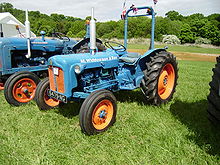
Agriculture remains a hazardous industry, and farmers worldwide remain at high risk of work-related injuries, lung disease, noise-induced hearing loss, skin diseases, as well as certain cancers related to chemical use and prolonged sun exposure. On industrialized farms, injuries frequently involve the use of agricultural machinery, and a common cause of fatal agricultural injuries in developed countries is tractor rollovers.[21] Pesticides and other chemicals used in farming can also be hazardous to worker health, and workers exposed to pesticides may experience illness or have children with birth defects.[22] As an industry in which families commonly share in work and live on the farm itself, entire families can be at risk for injuries, illness, and death.[23] Common causes of fatal injuries among young farm workers include drowning, machinery and motor vehicle-related accidents.[23]
The International Labour Organization considers agriculture "one of the most hazardous of all economic sectors."[17] It estimates that the annual work-related death toll among agricultural employees is at least 170,000, twice the average rate of other jobs. In addition, incidences of death, injury and illness related to agricultural activities often go unreported.[24] The organization has developed the Safety and Health in Agriculture Convention, 2001, which covers the range of risks in the agriculture occupation, the prevention of these risks and the role that individuals and organizations engaged in agriculture should play.[17]
Agricultural production systems
Crop cultivation systems

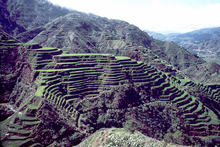
Cropping systems vary among farms depending on the available resources and constraints; geography and climate of the farm; government policy; economic, social and political pressures; and the philosophy and culture of the farmer.[25][26]
Shifting cultivation (or slash and burn) is a system in which forests are burnt, releasing nutrients to support cultivation of annual and then perennial crops for a period of several years.[27] Then the plot is left fallow to regrow forest, and the farmer moves to a new plot, returning after many more years (10–20). This fallow period is shortened if population density grows, requiring the input of nutrients (fertilizer or manure) and some manual pest control. Annual cultivation is the next phase of intensity in which there is no fallow period. This requires even greater nutrient and pest control inputs.
Further industrialization led to the use of monocultures, when one cultivar is planted on a large acreage. Because of the low biodiversity, nutrient use is uniform and pests tend to build up, necessitating the greater use of pesticides and fertilizers.[26] Multiple cropping, in which several crops are grown sequentially in one year, and intercropping, when several crops are grown at the same time, are other kinds of annual cropping systems known as polycultures.[27]
In subtropical and arid environments, the timing and extent of agriculture may be limited by rainfall, either not allowing multiple annual crops in a year, or requiring irrigation. In all of these environments perennial crops are grown (coffee, chocolate) and systems are practiced such as agroforestry. In temperate environments, where ecosystems were predominantly grassland or prairie, highly productive annual cropping is the dominant farming system.[27]
Crop statistics
Important categories of crops include cereals and pseudocereals, pulses (legumes), forage, and fruits and vegetables. Specific crops are cultivated in distinct growing regions throughout the world. In millions of metric tons, based on FAO estimate.
| Top agricultural products, by crop types (million tonnes) 2004 data | |
|---|---|
| Cereals | 2,263 |
| Vegetables and melons | 866 |
| Roots and tubers | 715 |
| Milk | 619 |
| Fruit | 503 |
| Meat | 259 |
| Oilcrops | 133 |
| Fish (2001 estimate) | 130 |
| Eggs | 63 |
| Pulses | 60 |
| Vegetable fiber | 30 |
| Source: Food and Agriculture Organization (FAO)[28] | |
| Top agricultural products, by individual crops (million tonnes) 2011 data | |
|---|---|
| Sugar cane | 1794 |
| Maize | 883 |
| Rice | 722 |
| Wheat | 704 |
| Potatoes | 374 |
| Sugar beet | 271 |
| Soybeans | 260 |
| Cassava | 252 |
| Tomatoes | 159 |
| Barley | 134 |
| Source: Food and Agriculture Organization (FAO)[28] | |
Livestock production systems

Animals, including horses, mules, oxen, water buffalo, camels, llamas, alpacas, donkeys, and dogs, are often used to help cultivate fields, harvest crops, wrangle other animals, and transport farm products to buyers. Animal husbandry not only refers to the breeding and raising of animals for meat or to harvest animal products (like milk, eggs, or wool) on a continual basis, but also to the breeding and care of species for work and companionship.

Livestock production systems can be defined based on feed source, as grassland-based, mixed, and landless.[29] As of 2010[update], 30% of Earth's ice- and water-free area was used for producing livestock, with the sector employing approximately 1.3 billion people. Between the 1960s and the 2000s, there was a significant increase in livestock production, both by numbers and by carcass weight, especially among beef, pigs and chickens, the latter of which had production increased by almost a factor of 10. Non-meat animals, such as milk cows and egg-producing chickens, also showed significant production increases. Global cattle, sheep and goat populations are expected to continue to increase sharply through 2050.[30] Aquaculture or fish farming, the production of fish for human consumption in confined operations, is one of the fastest growing sectors of food production, growing at an average of 9% a year between 1975 and 2007.[31]
During the second half of the 20th century, producers using selective breeding focused on creating livestock breeds and crossbreeds that increased production, while mostly disregarding the need to preserve genetic diversity. This trend has led to a significant decrease in genetic diversity and resources among livestock breeds, leading to a corresponding decrease in disease resistance and local adaptations previously found among traditional breeds.[32]
Grassland based livestock production relies upon plant material such as shrubland, rangeland, and pastures for feeding ruminant animals. Outside nutrient inputs may be used, however manure is returned directly to the grassland as a major nutrient source. This system is particularly important in areas where crop production is not feasible because of climate or soil, representing 30–40 million pastoralists.[27] Mixed production systems use grassland, fodder crops and grain feed crops as feed for ruminant and monogastric (one stomach; mainly chickens and pigs) livestock. Manure is typically recycled in mixed systems as a fertilizer for crops.[29]
Landless systems rely upon feed from outside the farm, representing the de-linking of crop and livestock production found more prevalently in Organisation for Economic Co-operation and Development(OECD) member countries. Synthetic fertilizers are more heavily relied upon for crop production and manure utilization becomes a challenge as well as a source for pollution.[29] Industrialized countries use these operations to produce much of the global supplies of poultry and pork. Scientists estimate that 75% of the growth in livestock production between 2003 and 2030 will be in confined animal feeding operations, sometimes called factory farming. Much of this growth is happening in developing countries in Asia, with much smaller amounts of growth in Africa.[30] Some of the practices used in commercial livestock production, including the usage of growth hormones, are controversial.[33]
Production practices

Tillage is the practice of plowing soil to prepare for planting or for nutrient incorporation or for pest control. Tillage varies in intensity from conventional to no-till. It may improve productivity by warming the soil, incorporating fertilizer and controlling weeds, but also renders soil more prone to erosion, triggers the decomposition of organic matter releasing CO2, and reduces the abundance and diversity of soil organisms.[34][35]
Pest control includes the management of weeds, insects, mites, and diseases. Chemical (pesticides), biological (biocontrol), mechanical (tillage), and cultural practices are used. Cultural practices include crop rotation, culling, cover crops, intercropping, composting, avoidance, and resistance. Integrated pest management attempts to use all of these methods to keep pest populations below the number which would cause economic loss, and recommends pesticides as a last resort.[36]
Nutrient management includes both the source of nutrient inputs for crop and livestock production, and the method of utilization of manure produced by livestock. Nutrient inputs can be chemical inorganic fertilizers, manure, green manure, compost and mined minerals.[37] Crop nutrient use may also be managed using cultural techniques such as crop rotation or a fallow period.[38][39] Manure is used either by holding livestock where the feed crop is growing, such as in managed intensive rotational grazing, or by spreading either dry or liquid formulations of manure on cropland or pastures.
Water management is needed where rainfall is insufficient or variable, which occurs to some degree in most regions of the world.[27] Some farmers use irrigation to supplement rainfall. In other areas such as the Great Plains in the U.S. and Canada, farmers use a fallow year to conserve soil moisture to use for growing a crop in the following year.[40] Agriculture represents 70% of freshwater use worldwide.[41]
According to a report by the International Food Policy Research Institute, agricultural technologies will have the greatest impact on food production if adopted in combination with each other; using a model that assessed how eleven technologies could impact agricultural productivity, food security and trade by 2050, the International Food Policy Research Institute found that the number of people at risk from hunger could be reduced by as much as 40% and food prices could be reduced by almost half.[42]
"Payment for ecosystem services (PES) can further incentivise efforts to green the agriculture sector. This is an approach that verifies values and rewards the benefits of ecosystem services provided by green agricultural practices."[43] "Innovative PES measures could include reforestation payments made by cities to upstream communities in rural areas of shared watersheds for improved quantities and quality of fresh water for municipal users. Ecoservice payments by farmers to upstream forest stewards for properly managing the flow of soil nutrients, and methods to monetise the carbon sequestration and emission reduction credit benefits of green agriculture practices in order to compensate farmers for their efforts to restore and build SOM and employ other practices." [43]
Crop alteration and biotechnology

Crop alteration has been practiced by humankind for thousands of years, since the beginning of civilization. Altering crops through breeding practices changes the genetic make-up of a plant to develop crops with more beneficial characteristics for humans, for example, larger fruits or seeds, drought-tolerance, or resistance to pests. Significant advances in plant breeding ensued after the work of geneticist Gregor Mendel. His work on dominant and recessive alleles, although initially largely ignored for almost 50 years, gave plant breeders a better understanding of genetics and breeding techniques. Crop breeding includes techniques such as plant selection with desirable traits, self-pollination and cross-pollination, and molecular techniques that genetically modify the organism.[44]
Domestication of plants has, over the centuries increased yield, improved disease resistance and drought tolerance, eased harvest and improved the taste and nutritional value of crop plants. Careful selection and breeding have had enormous effects on the characteristics of crop plants. Plant selection and breeding in the 1920s and 1930s improved pasture (grasses and clover) in New Zealand. Extensive X-ray and ultraviolet induced mutagenesis efforts (i.e. primitive genetic engineering) during the 1950s produced the modern commercial varieties of grains such as wheat, corn (maize) and barley.[45][46]
The Green Revolution popularized the use of conventional hybridization to sharply increase yield by creating "high-yielding varieties". For example, average yields of corn (maize) in the USA have increased from around 2.5 tons per hectare (t/ha) (40 bushels per acre) in 1900 to about 9.4 t/ha (150 bushels per acre) in 2001. Similarly, worldwide average wheat yields have increased from less than 1 t/ha in 1900 to more than 2.5 t/ha in 1990. South American average wheat yields are around 2 t/ha, African under 1 t/ha, and Egypt and Arabia up to 3.5 to 4 t/ha with irrigation. In contrast, the average wheat yield in countries such as France is over 8 t/ha. Variations in yields are due mainly to variation in climate, genetics, and the level of intensive farming techniques (use of fertilizers, chemical pest control, growth control to avoid lodging).[47][48][49]
Genetic engineering
Genetically modified organisms (GMO) are organisms whose genetic material has been altered by genetic engineering techniques generally known as recombinant DNA technology. Genetic engineering has expanded the genes available to breeders to utilize in creating desired germlines for new crops. Increased durability, nutritional content, insect and virus resistance and herbicide tolerance are a few of the attributes bred into crops through genetic engineering.[50] For some, GMO crops cause food safety and food labeling concerns. Numerous countries have placed restrictions on the production, import or use of GMO foods and crops, which have been put in place due to concerns over potential health issues, declining agricultural diversity and contamination of non-GMO crops.[51] Currently a global treaty, the Biosafety Protocol, regulates the trade of GMOs. There is ongoing discussion regarding the labeling of foods made from GMOs, and while the EU currently requires all GMO foods to be labeled, the US does not.[52]
Herbicide-resistant seed has a gene implanted into its genome that allows the plants to tolerate exposure to herbicides, including glyphosates. These seeds allow the farmer to grow a crop that can be sprayed with herbicides to control weeds without harming the resistant crop. Herbicide-tolerant crops are used by farmers worldwide.[53] With the increasing use of herbicide-tolerant crops, comes an increase in the use of glyphosate-based herbicide sprays. In some areas glyphosate resistant weeds have developed, causing farmers to switch to other herbicides.[54][55] Some studies also link widespread glyphosate usage to iron deficiencies in some crops, which is both a crop production and a nutritional quality concern, with potential economic and health implications.[56]
Other GMO crops used by growers include insect-resistant crops, which have a gene from the soil bacterium Bacillus thuringiensis (Bt), which produces a toxin specific to insects. These crops protect plants from damage by insects.[57] Some believe that similar or better pest-resistance traits can be acquired through traditional breeding practices, and resistance to various pests can be gained through hybridization or cross-pollination with wild species. In some cases, wild species are the primary source of resistance traits; some tomato cultivars that have gained resistance to at least 19 diseases did so through crossing with wild populations of tomatoes.[58]
Environmental impact
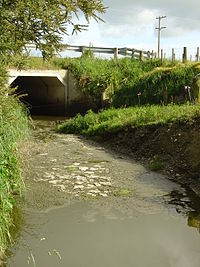
Agriculture imposes external costs upon society through pesticides, nutrient runoff, excessive water usage, loss of natural environment and assorted other problems. A 2000 assessment of agriculture in the UK determined total external costs for 1996 of £2,343 million, or £208 per hectare.[59] A 2005 analysis of these costs in the USA concluded that cropland imposes approximately $5 to 16 billion ($30 to $96 per hectare), while livestock production imposes $714 million.[60] Both studies, which focused solely on the fiscal impacts, concluded that more should be done to internalize external costs. Neither included subsidies in their analysis, but they noted that subsidies also influence the cost of agriculture to society.[59][60] In 2010, the International Resource Panel of the United Nations Environment Programme published a report assessing the environmental impacts of consumption and production. The study found that agriculture and food consumption are two of the most important drivers of environmental pressures, particularly habitat change, climate change, water use and toxic emissions.[61] The 2011 UNEP Green Economy report states that "[a]gricultural operations, excluding land use changes, produce approximately 13 per cent of anthropogenic global GHG emissions. This includes GHGs emitted by the use of inorganic fertilisers agro-chemical pesticides and herbicides; (GHG emissions resulting from production of these inputs are included in industrial emissions); and fossil fuel-energy inputs.[43] "On average we find that the total amount of fresh residues from agricultural and forestry production for second- generation biofuel production amounts to 3.8 billion tonnes per year between 2011 and 2050 (with an average annual growth rate of 11 per cent throughout the period analysed, accounting for higher growth during early years, 48 per cent for 2011-2020 and an average 2 per cent annual expansion after 2020)." [43]
Livestock issues
A senior UN official and co-author of a UN report detailing this problem, Henning Steinfeld, said "Livestock are one of the most significant contributors to today's most serious environmental problems".[62] Livestock production occupies 70% of all land used for agriculture, or 30% of the land surface of the planet. It is one of the largest sources of greenhouse gases, responsible for 18% of the world's greenhouse gas emissions as measured in CO2 equivalents. By comparison, all transportation emits 13.5% of the CO2. It produces 65% of human-related nitrous oxide (which has 296 times the global warming potential of CO2,) and 37% of all human-induced methane (which is 23 times as warming as CO2.) It also generates 64% of the ammonia emission. Livestock expansion is cited as a key factor driving deforestation; in the Amazon basin 70% of previously forested area is now occupied by pastures and the remainder used for feedcrops.[63] Through deforestation and land degradation, livestock is also driving reductions in biodiversity. Furthermore, the UNEP states that "methane emissions from global livestock are projected to increase by 60 per cent by 2030 under current practices and consumption patterns." [43]
Land and water issues
Land transformation, the use of land to yield goods and services, is the most substantial way humans alter the Earth's ecosystems, and is considered the driving force in the loss of biodiversity. Estimates of the amount of land transformed by humans vary from 39 to 50%.[64] Land degradation, the long-term decline in ecosystem function and productivity, is estimated to be occurring on 24% of land worldwide, with cropland overrepresented.[65] The UN-FAO report cites land management as the driving factor behind degradation and reports that 1.5 billion people rely upon the degrading land. Degradation can be deforestation, desertification, soil erosion, mineral depletion, or chemical degradation (acidification and salinization).[27]
Eutrophication, excessive nutrients in aquatic ecosystems resulting in algal blooms and anoxia, leads to fish kills, loss of biodiversity, and renders water unfit for drinking and other industrial uses. Excessive fertilization and manure application to cropland, as well as high livestock stocking densities cause nutrient (mainly nitrogen and phosphorus) runoff and leaching from agricultural land. These nutrients are major nonpoint pollutants contributing to eutrophication of aquatic ecosystems.[66]
Agriculture accounts for 70% of withdrawals of freshwater resources.[67] Agriculture is a major draw on water from aquifers, and currently draws from those underground water sources at an unsustainable rate. It is long known that aquifers in areas as diverse as northern China, the Upper Ganges and the western US are being depleted, and new research extends these problems to aquifers in Iran, Mexico and Saudi Arabia.[68] Increasing pressure is being placed on water resources by industry and urban areas, meaning that water scarcity is increasing and agriculture is facing the challenge of producing more food for the world's growing population with reduced water resources.[69] Agricultural water usage can also cause major environmental problems, including the destruction of natural wetlands, the spread of water-borne diseases, and land degradation through salinization and waterlogging, when irrigation is performed incorrectly.[70]
Pesticides
Pesticide use has increased since 1950 to 2.5 million tons annually worldwide, yet crop loss from pests has remained relatively constant.[71] The World Health Organization estimated in 1992 that 3 million pesticide poisonings occur annually, causing 220,000 deaths.[72] Pesticides select for pesticide resistance in the pest population, leading to a condition termed the 'pesticide treadmill' in which pest resistance warrants the development of a new pesticide.[73]
An alternative argument is that the way to 'save the environment' and prevent famine is by using pesticides and intensive high yield farming, a view exemplified by a quote heading the Center for Global Food Issues website: 'Growing more per acre leaves more land for nature'.[74][75] However, critics argue that a trade-off between the environment and a need for food is not inevitable,[76] and that pesticides simply replace good agronomic practices such as crop rotation.[73] The UNEP introduces the Push–pull agricultural pest management technique which involves intercropping that uses plant aromas to repel or push away pests while pulling in or attracting the right insects. "The implementation of push-pull in eastern Africa has significantly increased maize yields and the combined cultivation of N-fixing forage crops has enriched the soil and has also provided farmers with feed for livestock. With increased livestock operations, the farmers are able to produce meat, milk and other dairy products and they use the manure as organic fertiliser that returns nutrients to the fields." [43]
Climate change
Climate change has the potential to affect agriculture through changes in temperature, rainfall (timing and quantity), CO2, solar radiation and the interaction of these elements.[27] Extreme events, such as droughts and floods, are forecast to increase as climate change takes hold.[77] Agriculture is among sectors most vulnerable to the impacts of climate change; water supply for example, will be critical to sustain agricultural production and provide the increase in food output required to sustain the world's growing population. Fluctuations in the flow of rivers are likely to increase in the twenty-first century. Based on the experience of countries in the Nile river basin (Ethiopia, Kenya and Sudan) and other developing countries, depletion of water resources during seasons crucial for agriculture can lead to a decline in yield by up to 50%.[78] Transformational approaches will be needed to manage natural resources in the future.[79] For example, policies, practices and tools promoting climate-smart agriculture will be important, as will better use of scientific information on climate for assessing risks and vulnerability. Planners and policy-makers will need to help create suitable policies that encourage funding for such agricultural transformation.[80]
Agriculture can both mitigate or worsen global warming. Some of the increase in CO2 in the atmosphere comes from the decomposition of organic matter in the soil, and much of the methane emitted into the atmosphere is caused by the decomposition of organic matter in wet soils such as rice paddies,[81] as well as the normal digestive activities of farm animals. Further, wet or anaerobic soils also lose nitrogen through denitrification, releasing the greenhouse gases nitric oxide and nitrous oxide.[82] Changes in management can reduce the release of these greenhouse gases, and soil can further be used to sequester some of the CO2 in the atmosphere.[81] Informed by the UNEP, "[a]griculture also produces about 58 per cent of global nitrous oxide emissions and about 47 per cent of global methane emissions. Both of these gases have a far greater global warming potential per tonne than CO2 (298 times and 25 times respectively)." [43]
There are several factors within the field of agriculture that contribute to the large amount of CO2 emissions. The diversity of the sources ranges from the production of farming tools to the transport of harvested produce. Approximately 8% of the national carbon footprint is due to agricultural sources. Of that, 75% is of the carbon emissions released from the production of crop assisting chemicals.[83] Factories producing insecticides, herbicides, fungicides, and fertilizers are a major culprit of the greenhouse gas. Productivity on the farm itself and the use of machinery is another source of the carbon emission. Almost all the industrial machines used in modern farming are powered by fossil fuels. These instruments are burning fossil fuels from the beginning of the process to the end. Tractors are the root of this source. The tractor is going to burn fuel and release CO2 just to run. The amount of emissions from the machinery increase with the attachment of different units and need for more power. During the soil preparation stage tillers and plows will be used to disrupt the soil. During growth watering pumps and sprayers are used to keep the crops hydrated. And when the crops are ready for picking a forage or combine harvester is used. These types of machinery all require additional energy which leads to increased carbon dioxide emissions from the basic tractors.[84] The final major contribution to CO2 emissions in agriculture is in the final transport of produce. Local farming suffered a decline over the past century due to large amounts of farm subsidies. The majority of crops are shipped hundreds of miles to various processing plants before ending up in the grocery store. These shipments are made using fossil fuel burning modes of transportation. Inevitably these transport adds to carbon dioxide emissions.[85]
Sustainability
Some major organizations are hailing farming within agroecosystems as the way forward for mainstream agriculture. Current farming methods have resulted in over-stretched water resources, high levels of erosion and reduced soil fertility. According to a report by the International Water Management Institute and UNEP,[86] there is not enough water to continue farming using current practices; therefore how critical water, land, and ecosystem resources are used to boost crop yields must be reconsidered. The report suggested assigning value to ecosystems, recognizing environmental and livelihood tradeoffs, and balancing the rights of a variety of users and interests. Inequities that result when such measures are adopted would need to be addressed, such as the reallocation of water from poor to rich, the clearing of land to make way for more productive farmland, or the preservation of a wetland system that limits fishing rights.[87]
Technological advancements help provide farmers with tools and resources to make farming more sustainable.[88] New technologies have given rise to innovations like conservation tillage, a farming process which helps prevent land loss to erosion, water pollution and enhances carbon sequestration.[89]
According to a report by the International Food Policy Research Institute (IFPRI),[42] agricultural technologies will have the greatest impact on food production if adopted in combination with each other; using a model that assessed how eleven technologies could impact agricultural productivity, food security and trade by 2050, IFPRI found that the number of people at risk from hunger could be reduced by as much as 40% and food prices could be reduced by almost half.
Agricultural economics
Agricultural economics refers to economics as it relates to the "production, distribution and consumption of [agricultural] goods and services".[90] Combining agricultural production with general theories of marketing and business as a discipline of study began in the late 1800s, and grew significantly through the 20th century.[91] Although the study of agricultural economics is relatively recent, major trends in agriculture have significantly affected national and international economies throughout history, ranging from tenant farmers and sharecropping in the post-American Civil War Southern United States[92] to the European feudal system of manorialism.[93] In the United States, and elsewhere, food costs attributed to food processing, distribution, and agricultural marketing, sometimes referred to as the value chain, have risen while the costs attributed to farming have declined. This is related to the greater efficiency of farming, combined with the increased level of value addition (e.g. more highly processed products) provided by the supply chain. Market concentration has increased in the sector as well, and although the total effect of the increased market concentration is likely increased efficiency, the changes redistribute economic surplus from producers (farmers) and consumers, and may have negative implications for rural communities.[94]
National government policies can significantly change the economic marketplace for agricultural products, in the form of taxation, subsidies, tariffs and other measures.[95] Since at least the 1960s, a combination of import/export restrictions, exchange rate policies and subsidies have affected farmers in both the developing and developed world. In the 1980s, it was clear that non-subsidized farmers in developing countries were experiencing adverse affects from national policies that created artificially low global prices for farm products. Between the mid-1980s and the early 2000s, several international agreements were put into place that limited agricultural tariffs, subsidies and other trade restrictions.[96]
However, as of 2009[update], there was still a significant amount of policy-driven distortion in global agricultural product prices. The three agricultural products with the greatest amount of trade distortion were sugar, milk and rice, mainly due to taxation. Among the oilseeds, sesame had the greatest amount of taxation, but overall, feed grains and oilseeds had much lower levels of taxation than livestock products. Since the 1980s, policy-driven distortions have seen a greater decrease among livestock products than crops during the worldwide reforms in agricultural policy.[97] Despite this progress, certain crops, such as cotton, still see subsidies in developed countries artificially deflating global prices, causing hardship in developing countries with non-subsidized farmers.[98] Unprocessed commodities (i.e. corn, soybeans, cows) are generally graded to indicate quality. The quality affects the price the producer receives. Commodities are generally reported by production quantities, such as volume, number or weight.[99]
Agricultural science
This article needs additional citations for verification. (March 2018) |
| Agriculture |
|---|
 |
|
|
Agricultural science (or agriscience for short[100]) is a broad multidisciplinary field of biology that encompasses the parts of exact, natural, economic and social sciences that are used in the practice and understanding of agriculture. Professionals of the agricultural science are called agricultural scientists or agriculturists.
History
In the 18th century, Johann Friedrich Mayer conducted experiments on the use of gypsum (hydrated calcium sulphate) as a fertilizer.[101]
In 1843, John Bennet Lawes and Joseph Henry Gilbert began a set of long-term field experiments at Rothamsted Research in England, some of which are still running as of 2018.[102][103][104]
In the United States, a scientific revolution in agriculture began with the Hatch Act of 1887, which used the term "agricultural science".[105][106] The Hatch Act was driven by farmers' interest in knowing the constituents of early artificial fertilizer. The Smith–Hughes Act of 1917 shifted agricultural education back to its vocational roots, but the scientific foundation had been built.[107] For the next 44 years after 1906, federal expenditures on agricultural research in the United States outpaced private expenditures.[108]: xxi
Prominent agricultural scientists

- Wilbur Olin Atwater
- Robert Bakewell
- Norman Borlaug
- Luther Burbank
- George Washington Carver
- Carl Henry Clerk
- George C. Clerk
- René Dumont
- Sir Albert Howard
- Kailas Nath Kaul
- Thomas Lecky
- Justus von Liebig
- Jay Laurence Lush
- Gregor Mendel
- Louis Pasteur
- M. S. Swaminathan
- Jethro Tull
- Artturi Ilmari Virtanen
- Sewall Wright
- Agricultural biotechnology
- Agricultural chemistry
- Agricultural diversification
- Agricultural education
- Agricultural economics
- Agricultural engineering
- Agricultural geography
- Agricultural philosophy
- Agricultural marketing
- Agricultural soil science
- Agroecology
- Agrophysics
- Animal science
- Farm management
- Agronomy
- Fisheries science
- Biological engineering
- Nematology
- Microbiology
- Range management
- Environmental science
- Entomology
- Food science
- Irrigation and water management
- Soil science
- Waste management
- Weed science
Scope
Agriculture, agricultural science, and agronomy are closely related. However, they cover different concepts:
- Agriculture is the set of activities that transform the environment for the production of animals and plants for human use. Agriculture concerns techniques, including the application of agronomic research.
- Agronomy is research and development related to studying and improving plant-based crops.
Soil forming factors and soil degradation
Agricultural sciences include research and development on:[109][110]
- Improving agricultural productivity in terms of quantity and quality (e.g., selection of drought-resistant crops and animals, development of new pesticides, yield-sensing technologies, simulation models of crop growth, in-vitro cell culture techniques)
- Minimizing the effects of pests (weeds, insects, pathogens, mollusks, nematodes) on crop or animal production systems.
- Transformation of primary products into end-consumer products (e.g., production, preservation, and packaging of dairy products)
- Prevention and correction of adverse environmental effects (e.g., soil degradation, waste management, bioremediation)
- Theoretical production ecology, relating to crop production modeling
- Traditional agricultural systems, sometimes termed subsistence agriculture, which feed most of the poorest people in the world. These systems are of interest as they sometimes retain a level of integration with natural ecological systems greater than that of industrial agriculture, which may be more sustainable than some modern agricultural systems.
- Food production and demand on a global basis, with special attention paid to the major producers, such as China, India, Brazil, the US and the EU.
- Various sciences relating to agricultural resources and the environment (e.g. soil science, agroclimatology); biology of agricultural crops and animals (e.g. crop science, animal science and their included sciences, e.g. ruminant nutrition, farm animal welfare); such fields as agricultural economics and rural sociology; various disciplines encompassed in agricultural engineering.
See also
- Agricultural Research Council
- Agricultural sciences basic topics
- Agriculture ministry
- Agroecology
- American Society of Agronomy
- Genomics of domestication
- History of agricultural science
- Institute of Food and Agricultural Sciences
- International Assessment of Agricultural Science and Technology for Development
- International Food Policy Research Institute, IFPRI
- List of agriculture topics
- National FFA Organization
- Research Institute of Crop Production (RICP) (in the Czech Republic)
- University of Agricultural Sciences
References
- ^ Philpott, Tom (19 April 2013). "A Brief History of Our Deadly Addiction to Nitrogen Fertilizer". Mother Jones. Retrieved 7 May 2013.
- ^ Scheierling, Susanne M. (1995). "Overcoming agricultural pollution of water: the challenge of integrating agricultural and environmental policies in the European Union, Volume 1". The World Bank. Retrieved 15 April 2013.
- ^ "CAP Reform". European Commission. 2003. Retrieved 15 April 2013.
- ^ Smith, Kate; Edwards, Rob (8 March 2008). "2008: The year of global food crisis". The Herald. Glasgow.
{{cite journal}}: CS1 maint: multiple names: authors list (link) - ^ "The global grain bubble". The Christian Science Monitor. 18 January 2008. Retrieved 26 September 2013.
- ^ "The cost of food: Facts and figures". BBC News Online. 16 October 2008. Retrieved 26 September 2013.
{{cite web}}: Italic or bold markup not allowed in:|publisher=(help) - ^ Walt, Vivienne (27 February 2008). "The World's Growing Food-Price Crisis". Time.
- ^ Watts, Jonathan (4 December 2007). "Riots and hunger feared as demand for grain sends food costs soaring", The Guardian (London).
- ^ Mortished, Carl (7 March 2008)."Already we have riots, hoarding, panic: the sign of things to come?", The Times (London).
- ^ Borger, Julian (26 February 2008). "Feed the world? We are fighting a losing battle, UN admits", The Guardian (London).
- ^ "Food prices: smallholder farmers can be part of the solution". International Fund for Agricultural Development. Retrieved 24 April 2013.
- ^ "Wheat Stem Rust – UG99 (Race TTKSK)". FAO. Retrieved 6 January 2014.
- ^ Sample, Ian (31 August 2007). "Global food crisis looms as climate change and population growth strip fertile land", The Guardian (London).
- ^ "Africa may be able to feed only 25% of its population by 2025", mongabay.com, 14 December 2006.
- ^ M. Pietrzak, D. Walczak. 2014. The Analysis of the Agrarian Structure in Poland with the Special Consideration of the Years 1921 and 2002, Bulgarian Journal of Agricultural Science, Vol 20, No 5, pp. 1025, 1038.
- ^ "Agricultural Productivity in the United States". USDA Economic Research Service. 5 July 2012. Retrieved 22 April 2013.
- ^ a b c "Safety and health in agriculture". International Labour Organization. 21 March 2011. Retrieved 24 April 2013.
- ^ AP (26 January 2007). "Services sector overtakes farming as world's biggest employer: ILO". The Financial Express. Retrieved 24 April 2013.
{{cite web}}: Italic or bold markup not allowed in:|publisher=(help) - ^ a b "Labor Force – By Occupation". The World Factbook. Central Intelligence Agency. Retrieved 4 May 2013.
- ^ Allen, Robert C. "Economic structure and agricultural productivity in Europe, 1300–1800" (PDF). European Review of Economic History. 3: 1–25.
- ^ "NIOSH Workplace Safety & Health Topic: Agricultural Injuries". Centers for Disease Control and Prevention. Retrieved 16 April 2013.
- ^ "NIOSH Pesticide Poisoning Monitoring Program Protects Farmworkers". Centers for Disease Control and Prevention. Retrieved 15 April 2013.
- ^ a b "NIOSH Workplace Safety & Health Topic: Agriculture". Centers for Disease Control and Prevention. Retrieved 16 April 2013.
- ^ "Agriculture: A hazardous work". International Labour Organization. 15 June 2009. Retrieved 24 April 2013.
- ^ "Analysis of farming systems". Food and Agriculture Organization. Retrieved 22 May 2013.
- ^ a b Acquaah, G. 2002. Agricultural Production Systems. pp. 283–317 in "Principles of Crop Production, Theories, Techniques and Technology". Prentice Hall, Upper Saddle River, NJ.
- ^ a b c d e f g Chrispeels, M.J.; Sadava, D.E. 1994. "Farming Systems: Development, Productivity, and Sustainability". pp. 25–57 in Plants, Genes, and Agriculture. Jones and Bartlett, Boston, MA.
- ^ a b "Food and Agriculture Organization of the United Nations (FAOSTAT)". Archived from the original on 18 January 2013. Retrieved 2 February 2013.
- ^ a b c Sere, C.; Steinfeld, H.; Groeneweld, J. (1995). "Description of Systems in World Livestock Systems – Current status issues and trends". U.N. Food and Agriculture Organization. Retrieved 8 September 2013.
{{cite web}}: CS1 maint: multiple names: authors list (link) - ^ a b Thornton, Philip K. (27 September 2010). "Livestock production: recent trends, future prospects". Philosophical Transactions of the Royal Society B. 365 (1554). doi:10.1098/rstb.2010.0134.
- ^ Stier, Ken (19 September 2007). "Fish Farming's Growing Dangers". Time.
- ^ P. Ajmone-Marsan (May 2010). "A global view of livestock biodiversity and conservation – GLOBALDIV". Animal Genetics. 41 (supplement S1): 1–5. doi:10.1111/j.1365-2052.2010.02036.x.
- ^ "Growth Promoting Hormones Pose Health Risk to Consumers, Confirms EU Scientific Committee" (PDF). European Union. 23 April 2002. Retrieved 6 April 2013.
- ^ Brady, N.C. and R.R. Weil. 2002. Elements of the Nature and Properties of Soils. Pearson Prentice Hall, Upper Saddle River, NJ.
- ^ Acquaah, G. 2002. "Land Preparation and Farm Energy" pp.318–338 in Principles of Crop Production, Theories, Techniques and Technology. Prentice Hall, Upper Saddle River, NJ.
- ^ Acquaah, G. 2002. "Pesticide Use in U.S. Crop Production" pp.240–282 in Principles of Crop Production, Theories, Techniques and Technology. Prentice Hall, Upper Saddle River, NJ.
- ^ Acquaah, G. 2002. "Soil and Land" pp.165–210 in Principles of Crop Production, Theories, Techniques and Technology. Prentice Hall, Upper Saddle River, NJ.
- ^ Chrispeels, M.J.; Sadava, D.E. 1994. "Nutrition from the Soil" pp.187–218 in Plants, Genes, and Agriculture. Jones and Bartlett, Boston, MA.
- ^ Brady, N.C.; Weil, R.R. 2002. "Practical Nutrient Management" pp.472–515 in Elements of the Nature and Properties of Soils. Pearson Prentice Hall, Upper Saddle River, NJ.
- ^ Acquaah, G. 2002. "Plants and Soil Water" pp.211–239 in Principles of Crop Production, Theories, Techniques and Technology. Prentice Hall, Upper Saddle River, NJ.
- ^ Pimentel, D.; Berger, D.; Filberto, D.; Newton, M.; et al. (2004). "Water Resources: Agricultural and Environmental Issues". BioScience. 54 (10): 909–918. doi:10.1641/0006-3568(2004)054[0909:WRAAEI]2.0.CO;2.
{{cite journal}}: CS1 maint: multiple names: authors list (link) - ^ a b International Food Policy Research Institute (2014). "Food Security in a World of Growing Natural Resource Scarcity". CropLife International. Retrieved 1 July 2013.
{{cite web}}:|author=has generic name (help) - ^ a b c d e f g UNEP, 2011, Towards a Green Economy: Pathways to Sustainable Development and Poverty Eradication, www.unep.org/greeneconomy
- ^ "History of Plant Breeding". Colorado State University. 29 January 2004. Retrieved 11 May 2013.
- ^ Stadler, L. J.; Sprague, G.F. (15 October 1936). "Genetic Effects of Ultra-Violet Radiation in Maize: I. Unfiltered Radiation" (PDF). Proceedings of the National Academy of Sciences of the United States of America. 22 (10). US Department of Agriculture and Missouri Agricultural Experiment Station: 572–578. doi:10.1073/pnas.22.10.572. PMC 1076819. PMID 16588111. Archived from the original (PDF) on 24 October 2007. Retrieved 11 October 2007.
{{cite journal}}: Unknown parameter|deadurl=ignored (|url-status=suggested) (help) - ^ Berg, Paul; Singer, Maxine (15 August 2003). George Beadle: An Uncommon Farmer. The Emergence of Genetics in the 20th century. Cold Springs Harbor Laboratory Press. ISBN 978-0-87969-688-7.
- ^ Ruttan, Vernon W. (December 1999). "Biotechnology and Agriculture: A Skeptical Perspective" (PDF). AgBioForum. 2 (1): 54–60.
- ^ Cassman, K. (5 December 1998). "Ecological intensification of cereal production systems: The Challenge of increasing crop yield potential and precision agriculture". Proceedings of a National Academy of Sciences Colloquium, Irvine, California. University of Nebraska. Archived from the original on 24 October 2007. Retrieved 11 October 2007.
{{cite journal}}: Unknown parameter|deadurl=ignored (|url-status=suggested) (help) - ^ Conversion note: 1 bushel of wheat = 60 pounds (lb) ≈ 27.215 kg. 1 bushel of maize = 56 pounds ≈ 25.401 kg
- ^ "20 Questions on Genetically Modified Foods". World Health Organization. Retrieved 16 April 2013.
- ^ Whiteside, Stephanie (28 November 2012). "Peru bans genetically modified foods as US lags". Current TV. Retrieved 7 May 2013.
- ^ Shiva, Vandana (2005). Earth Democracy: Justice, Sustainability, and Peace. Cambridge, MA: South End Press.
- ^ Kathrine Hauge Madsen and Jens Carl Streibig. "Benefits and risks of the use of herbicide-resistant crops". Weed Management for Developing Countries. FAO. Retrieved 4 May 2013.
- ^ "Farmers Guide to GMOs" (PDF). Rural Advancement Foundation International. Retrieved 16 April 2013.
- ^ Brian Hindo (13 February 2008). "Report Raises Alarm over 'Super-weeds'". Bloomberg BusinessWeek.
- ^ Ozturk; et al. (2008). "Glyphosate inhibition of ferric reductase activity in iron deficient sunflower roots". New Phytologist. 177: 899–906. doi:10.1111/j.1469-8137.2007.02340.x.
{{cite journal}}: Explicit use of et al. in:|last2=(help) - ^ "Insect-resistant Crops Through Genetic Engineering". University of Illinois. Retrieved 4 May 2013.
- ^ Kimbrell, A. (2002). Fatal Harvest: The Tragedy of Industrial Agriculture. Washington: Island Press.
- ^ a b Pretty, J; et al. (2000). "An assessment of the total external costs of UK agriculture". Agricultural Systems. 65 (2): 113–136. doi:10.1016/S0308-521X(00)00031-7.
- ^ a b Tegtmeier, E.M.; Duffy, M. (2005). "External Costs of Agricultural Production in the United States" (PDF). The Earthscan Reader in Sustainable Agriculture.
- ^ International Resource Panel (2010). "Priority products and materials: assessing the environmental impacts of consumption and production". United Nations Environment Programme. Retrieved 7 May 2013.
- ^ "Livestock a major threat to environment". UN Food and Agriculture Organization. 29 November 2006. Archived from the original on 28 March 2008. Retrieved 24 April 2013.
{{cite web}}: Unknown parameter|deadurl=ignored (|url-status=suggested) (help) - ^ Steinfeld, H.; Gerber, P.; Wassenaar, T.; Castel, V.; Rosales, M.; de Haan, C. (2006). "Livestock's Long Shadow – Environmental issues and options" (PDF). Rome: U.N. Food and Agriculture Organization. Archived from the original (PDF) on 25 June 2008. Retrieved 5 December 2008.
- ^ Vitousek, P.M.; Mooney, H.A.; Lubchenco, J.; Melillo, J.M. (1997). "Human Domination of Earth's Ecosystems". Science. 277 (5325): 494–499. doi:10.1126/science.277.5325.494.
{{cite journal}}: CS1 maint: multiple names: authors list (link) - ^ Bai, Z.G., D.L. Dent, L. Olsson, and M.E. Schaepman (November 2008). "Global assessment of land degradation and improvement: 1. identification by remote sensing" (PDF). FAO/ISRIC. Retrieved 24 May 2013.
{{cite web}}: CS1 maint: multiple names: authors list (link) - ^ Carpenter, S.R., N.F. Caraco, D.L. Correll, R.W. Howarth, A.N. Sharpley, and V.H. Smith (1998). "Nonpoint Pollution of Surface Waters with Phosphorus and Nitrogen". Ecological Applications. 8 (3): 559–568. doi:10.1890/1051-0761(1998)008[0559:NPOSWW]2.0.CO;2.
{{cite journal}}: CS1 maint: multiple names: authors list (link) - ^ Molden, D. (ed.). "Findings of the Comprehensive Assessment of Water Management in Agriculture" (PDF). Annual Report 2006/2007. International Water Management Institute. Retrieved 6 January 2014.
- ^ Li, Sophia (13 August 2012). "Stressed Aquifers Around the Globe". New York Times. Retrieved 7 May 2013.
{{cite web}}: Italic or bold markup not allowed in:|publisher=(help) - ^ "Water Use in Agriculture". FAO. November 2005. Retrieved 7 May 2013.
- ^ "Water Management: Towards 2030". FAO. March 2003. Retrieved 7 May 2013.
- ^ Pimentel, D. T.W. Culliney, and T. Bashore (1996). "Public health risks associated with pesticides and natural toxins in foods". Radcliffe's IPM World Textbook. Retrieved 7 May 2013.
{{cite web}}: CS1 maint: multiple names: authors list (link) - ^ WHO. 1992. Our planet, our health: Report of the WHO commission on health and environment. Geneva: World Health Organization.
- ^ a b Chrispeels, M.J. and D.E. Sadava. 1994. "Strategies for Pest Control" pp.355–383 in Plants, Genes, and Agriculture. Jones and Bartlett, Boston, MA.
- ^ Avery, D.T. (2000). Saving the Planet with Pesticides and Plastic: The Environmental Triumph of High-Yield Farming. Indianapolis, IN: Hudson Institute.
- ^ "Home". Center for Global Food Issues. Retrieved 24 May 2013.
- ^ Lappe, F.M., J. Collins, and P. Rosset. 1998. "Myth 4: Food vs. Our Environment" pp. 42–57 in World Hunger, Twelve Myths, Grove Press, New York.
- ^ Harvey, Fiona (18 November 2011). "Extreme weather will strike as climate change takes hold, IPCC warns". The Guardian.
- ^ "Report: Blue Peace for the Nile" (PDF). Strategic Foresight Group. Retrieved 20 August 2013.
- ^ "World: Pessimism about future grows in agribusiness".
- ^ "SREX: Lessons for the agricultural sector". Climate & Development Knowledge Network. Retrieved 24 May 2013.
- ^ a b Brady, N.C. and R.R. Weil. 2002. "Soil Organic Matter" pp. 353–385 in Elements of the Nature and Properties of Soils. Pearson Prentice Hall, Upper Saddle River, NJ.
- ^ Brady, N.C. and R.R. Weil. 2002. "Nitrogen and Sulfur Economy of Soils" pp. 386–421 in Elements of the Nature and Properties of Soils. Pearson Prentice Hall, Upper Saddle River, NJ.
- ^ Hillier, Jonathon; C. Hawes; G. Squire; A. Hilton (2009). "The carbon footprints of food crop production". International Journal of Agricultural Sustainability. 7 (2): 107–118. doi:10.3763/ijas.2009.0419.
- ^ Lal, Rattan (2004). "Carbon emission from farm operations". Environmental International. 30 (7): 981–990. doi:10.1016/j.envint.2004.03.005.
- ^ West, T.O.; G. Marland (2002). "Net carbon flux from agricultural ecosystems: methodology for full carbon cycle analyses". Environmental Pollution. 116 (3): 439–444. doi:10.1016/s0269-7491(01)00221-4.
- ^ Boelee, E. (Ed) (2011). "Ecosystems for water and food security". IWMI/UNEP. Retrieved 24 May 2013.
- ^ Molden, D. "Opinion: The Water Deficit" (PDF). The Scientist. Retrieved 23 August 2011.
{{cite web}}: Italic or bold markup not allowed in:|publisher=(help) - ^ Safefood Consulting, Inc. (2005). "Benefits of Crop Protection Technologies on Canadian Food Production, Nutrition, Economy and the Environment". CropLife International. Retrieved 24 May 2013.
- ^ Trewavas, Anthony (2004). "A critical assessment of organic farming-and-food assertions with particular respect to the UK and the potential environmental benefits of no-till agriculture". Crop Protection. 23 (9): 757–781. doi:10.1016/j.cropro.2004.01.009.
- ^ "Agricultural Economics". University of Idaho. Retrieved 16 April 2013.
- ^ Runge, C. Ford (June 2006). "Agricultural Economics: A Brief Intellectual History" (PDF). Center for International Food and Agriculture Policy. p. 4. Retrieved 16 September 2013.
- ^ Conrad, David E. "Tenant Farming and Sharecropping". Encyclopedia of Oklahoma History and Culture. Oklahoma Historical Society. Retrieved 16 September 2013.
- ^ Stokstad, Marilyn (2005). Medieval Castles. Greenwood Publishing Group. ISBN 0-313-32525-1.
- ^ Sexton, R.J. (2000). "Industrialization and Consolidation in the US Food Sector: Implications for Competition and Welfare". American Journal of Agricultural Economics. 82 (5): 1087–1104. doi:10.1111/0002-9092.00106.
- ^ Peter J. Lloyd, Johanna L. Croser, Kym Anderson (March 2009). "How Do Agricultural Policy Restrictions to Global Trade and Welfare Differ across Commodities?" (PDF). Policy Research Working Paper #4864. The World Bank. pp. 2–3. Retrieved 16 April 2013.
{{cite web}}: CS1 maint: multiple names: authors list (link) - ^ Kym Anderson and Ernesto Valenzuela (April 2006). "Do Global Trade Distortions Still Harm Developing Country Farmers?" (PDF). World Bank Policy Research Working Paper 3901. World Bank. pp. 1–2. Retrieved 16 April 2013.
- ^ Peter J. Lloyd, Johanna L. Croser, Kym Anderson (March 2009). "How Do Agricultural Policy Restrictions to Global Trade and Welfare Differ across Commodities?" (PDF). Policy Research Working Paper #4864. The World Bank. p. 21. Retrieved 16 April 2013.
{{cite web}}: CS1 maint: multiple names: authors list (link) - ^ Glenys Kinnock (24 May 2011). "America's $24bn subsidy damages developing world cotton farmers". The Guardian. Retrieved 16 April 2013.
- ^ "Agriculture's Bounty" (PDF). May 2013. Retrieved 19 August 2013.
- ^ "Agriscience | Meaning & Definition for UK English". Oxford Dictionary of English. Oxford University Press via Lexico. Archived from the original on 20 February 2022. Retrieved 20 February 2022.
- ^ John Armstrong, Jesse Buel. A Treatise on Agriculture, The Present Condition of the Art Abroad and at Home, and the Theory and Practice of Husbandry. To which is Added, a Dissertation on the Kitchen and Garden. 1840. p. 45.
- ^ "The Long Term Experiments". Rothamsted Research. Archived from the original on 27 March 2018. Retrieved 26 March 2018.
- ^ "Fertilizer History: The Haber-Bosch Process". tfi.org. 19 November 2014. Retrieved 14 December 2022.
- ^ "Lawes and Gilbert: an unlikely Victorian agricultural partnership". Harpenden History. Retrieved 14 December 2022.
- ^ "The Hatch Act of 1887". National Institute of Food and Agriculture. Retrieved 14 December 2022.
- ^ "Hatch Act of 1887". College of Life Sciences and Agriculture. 23 November 2020. Retrieved 14 December 2022.
- ^ Hillison J. (1996). The Origins of Agriscience: Or Where Did All That Scientific Agriculture Come From? Archived 2 October 2008 at the Wayback Machine. Journal of Agricultural Education.
- ^ Huffman WE, Evenson RE. (2006). Science for Agriculture. Blackwell Publishing.
- ^ Bosso, Thelma (2015). Agricultural Science. Callisto Reference. ISBN 978-1-63239-058-5.
- ^ Boucher, Jude (2018). Agricultural Science and Management. Callisto Reference. ISBN 978-1-63239-965-6.
Further reading
- Agricultural Research, Livelihoods, and Poverty: Studies of Economic and Social Impacts in Six Countries Edited by Michelle Adato and Ruth Meinzen-Dick (2007), Johns Hopkins University Press Food Policy Report[1]
- Claude Bourguignon, Regenerating the Soil: From Agronomy to Agrology, Other India Press, 2005
- Pimentel David, Pimentel Marcia, Computer les kilocalories, Cérès, n. 59, sept-oct. 1977
- Russell E. Walter, Soil conditions and plant growth, Longman group, London, New York 1973
- Salamini, Francesco; Özkan, Hakan; Brandolini, Andrea; Schäfer-Pregl, Ralf; Martin, William (2002). "Genetics and geography of wild cereal domestication in the near east". Nature Reviews Genetics. 3 (6): 429–441. doi:10.1038/nrg817. PMID 12042770. S2CID 25166879.
- Saltini Antonio, Storia delle scienze agrarie, 4 vols, Bologna 1984–89, ISBN 88-206-2412-5, ISBN 88-206-2413-3, ISBN 88-206-2414-1, ISBN 88-206-2415-X
- Vavilov Nicolai I. (Starr Chester K. editor), The Origin, Variation, Immunity and Breeding of Cultivated Plants. Selected Writings, in Chronica botanica, 13: 1–6, Waltham, Mass., 1949–50
- Vavilov Nicolai I., World Resources of Cereals, Leguminous Seed Crops and Flax, Academy of Sciences of Urss, National Science Foundation, Washington, Israel Program for Scientific Translations, Jerusalem 1960
- Winogradsky Serge, Microbiologie du sol. Problèmes et methodes. Cinquante ans de recherches, Masson & c.ie, Paris 1949
External links
- Consultative Group on International Agricultural Research (CGIAR)
- Agricultural Research Service
- Indian Council of Agricultural Research
- International Institute of Tropical Agriculture
- International Livestock Research Institute
- The National Agricultural Library (NAL) – The most comprehensive agricultural library in the world.
- Crop Science Society of America
- American Society of Agronomy
- Soil Science Society of America
- Agricultural Science Researchers, Jobs and Discussions
- Information System for Agriculture and Food Research
- NMSU Department of Entomology Plant Pathology and Weed Science
List of countries by agricultural output
| Economy | Countries by agricultural output in 2015 (billions in USD)
| ||||||||
|---|---|---|---|---|---|---|---|---|---|
| (01) |
1,088
| ||||||||
| (02) |
413
| ||||||||
| (—) |
333
| ||||||||
| (03) |
290
| ||||||||
| (04) |
127
| ||||||||
| (05) |
110
| ||||||||
| (06) |
106
| ||||||||
| (07) |
63
| ||||||||
| (08) |
62
| ||||||||
| (09) |
59
| ||||||||
| (10) |
51
| ||||||||
| (11) |
47
| ||||||||
| (12) |
47
| ||||||||
| (13) |
47
| ||||||||
| (14) |
46
| ||||||||
| (15) |
43
| ||||||||
| (16) |
42
| ||||||||
| (17) |
41
| ||||||||
| (18) |
39
| ||||||||
| (19) |
37
| ||||||||
| (20) |
36
| ||||||||
|
The twenty largest countries by agricultural output in 2015, according to the IMF and CIA World Factbook. | |||||||||
Energy and agriculture
Since the 1940s, agricultural productivity has increased dramatically, due largely to the increased use of energy-intensive mechanization, fertilizers and pesticides. The vast majority of this energy input comes from fossil fuel sources.[2] Between the 1960–65 measuring cycle and the cycle from 1986 to 1990, the Green Revolution transformed agriculture around the globe, with world grain production increasing significantly (between 70% and 390% for wheat and 60% to 150% for rice, depending on geographic area)[3] as world population doubled. Modern agriculture's heavy reliance on petrochemicals and mechanization has raised concerns that oil shortages could increase costs and reduce agricultural output, causing food shortages.[4]
| Agriculture and food system share (%) of total energy consumption by three industrialized nations | |||
|---|---|---|---|
| Country | Year | Agriculture (direct & indirect) |
Food system |
| United Kingdom[5] | 2005 | 1.9 | 11 |
| United States[6] | 1996 | 2.1 | 10 |
| United States[7] | 2002 | 2.0 | 14 |
| Sweden[8] | 2000 | 2.5 | 13 |
Modern or industrialized agriculture is dependent on fossil fuels in two fundamental ways: 1. direct consumption on the farm and 2. indirect consumption to manufacture inputs used on the farm. Direct consumption includes the use of lubricants and fuels to operate farm vehicles and machinery; and use of gasoline, liquid propane, and electricity to power dryers, pumps, lights, heaters, and coolers. American farms directly consumed about 1.2 exajoules (1.1 quadrillion BTU) in 2002, or just over 1% of the nation's total energy.[4]
Indirect consumption is mainly oil and natural gas used to manufacture fertilizers and pesticides, which accounted for 0.6 exajoules (0.6 quadrillion BTU) in 2002.[4] The natural gas and coal consumed by the production of nitrogen fertilizer can account for over half of the agricultural energy usage. China utilizes mostly coal in the production of nitrogen fertilizer, while most of Europe uses large amounts of natural gas and small amounts of coal. According to a 2010 report published by The Royal Society, agriculture is increasingly dependent on the direct and indirect input of fossil fuels. Overall, the fuels used in agriculture vary based on several factors, including crop, production system and location.[9] The energy used to manufacture farm machinery is also a form of indirect agricultural energy consumption. Together, direct and indirect consumption by US farms accounts for about 2% of the nation's energy use. Direct and indirect energy consumption by U.S. farms peaked in 1979, and has gradually declined over the past 30 years.[4] Food systems encompass not just agricultural production, but also off-farm processing, packaging, transporting, marketing, consumption, and disposal of food and food-related items. Agriculture accounts for less than one-fifth of food system energy use in the US.[6][7]
Mitigation of effects of petroleum shortages
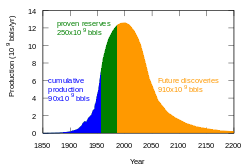
In the event of a petroleum shortage (see peak oil for global concerns), organic agriculture can be more attractive than conventional practices that use petroleum-based pesticides, herbicides, or fertilizers. Some studies using modern organic-farming methods have reported yields as high as those available from conventional farming.[11] In the aftermath of the fall of the Soviet Union, with shortages of conventional petroleum-based inputs, Cuba made use of mostly organic practices, including biopesticides, plant-based pesticides and sustainable cropping practices, to feed its populace.[12] However, organic farming may be more labor-intensive and would require a shift of the workforce from urban to rural areas.[13] The reconditioning of soil to restore nutrients lost during the use of monoculture agriculture techniques also takes time.[11]
It has been suggested that rural communities might obtain fuel from the biochar and synfuel process, which uses agricultural waste to provide charcoal fertilizer, some fuel and food, instead of the normal food vs. fuel debate. As the synfuel would be used on-site, the process would be more efficient and might just provide enough fuel for a new organic-agriculture fusion.[14][15]
It has been suggested that some transgenic plants may some day be developed which would allow for maintaining or increasing yields while requiring fewer fossil-fuel-derived inputs than conventional crops.[16] The possibility of success of these programs is questioned by ecologists and economists concerned with unsustainable GMO practices such as terminator seeds.[17][18] While there has been some research on sustainability using GMO crops, at least one prominent multi-year attempt by Monsanto Company has been unsuccessful, though during the same period traditional breeding techniques yielded a more sustainable variety of the same crop.[19]
Policy

Agricultural policy is the set of government decisions and actions relating to domestic agriculture and imports of foreign agricultural products. Governments usually implement agricultural policies with the goal of achieving a specific outcome in the domestic agricultural product markets. Some overarching themes include risk management and adjustment (including policies related to climate change, food safety and natural disasters), economic stability (including policies related to taxes), natural resources and environmental sustainability (especially water policy), research and development, and market access for domestic commodities (including relations with global organizations and agreements with other countries).[20] Agricultural policy can also touch on food quality, ensuring that the food supply is of a consistent and known quality, food security, ensuring that the food supply meets the population's needs, and conservation. Policy programs can range from financial programs, such as subsidies, to encouraging producers to enroll in voluntary quality assurance programs.[21]
There are many influences on the creation of agricultural policy, including consumers, agribusiness, trade lobbies and other groups. Agribusiness interests hold a large amount of influence over policy making, in the form of lobbying and campaign contributions. Political action groups, including those interested in environmental issues and labor unions, also provide influence, as do lobbying organizations representing individual agricultural commodities.[22] The Food and Agriculture Organization of the United Nations (FAO) leads international efforts to defeat hunger and provides a forum for the negotiation of global agricultural regulations and agreements. Dr. Samuel Jutzi, director of FAO's animal production and health division, states that lobbying by large corporations has stopped reforms that would improve human health and the environment. For example, proposals in 2010 for a voluntary code of conduct for the livestock industry that would have provided incentives for improving standards for health, and environmental regulations, such as the number of animals an area of land can support without long-term damage, were successfully defeated due to large food company pressure.[23]
See also
- Aeroponics
- Agricultural engineering
- Agricultural value chain
- Agroecology
- Building-integrated agriculture
- Contract farming
- Corporate farming
- Crofting
- Crop
- Ecoagriculture
- Feed additive
- Food security
- Hill farming
- List of documentary films about agriculture
- Pharming (genetics)
- Remote sensing
- Subsistence economy
- Vertical farming
References
- ^ Agricultural research, livelihoods, and poverty | International Food Policy Research Institute (IFPRI) Archived 26 June 2010 at the Wayback Machine
- ^ "World oil supplies are set to run out faster than expected, warn scientists". The Independent. 14 June 2007.
- ^ Robert W. Herdt (30 May 1997). "The Future of the Green Revolution: Implications for International Grain Markets" (PDF). The Rockefeller Foundation. p. 2. Retrieved 16 April 2013.
- ^ a b c d Schnepf, Randy (19 November 2004). "Energy use in Agriculture: Background and Issues" (PDF). CRS Report for Congress. Congressional Research Service. Retrieved 26 September 2013.
- ^ Rebecca White (2007). "Carbon governance from a systems perspective: an investigation of food production and consumption in the UK" (PDF). Oxford University Center for the Environment.
- ^ a b Martin Heller and Gregory Keoleian (2000). "Life Cycle-Based Sustainability Indicators for Assessment of the U.S. Food System" (PDF). University of Michigan Center for Sustainable Food Systems.
- ^ a b Patrick Canning, Ainsley Charles, Sonya Huang, Karen R. Polenske, and Arnold Waters (2010). "Energy Use in the U.S. Food System". USDA Economic Research Service Report No. ERR-94. United States Department of Agriculture.
{{cite web}}: CS1 maint: multiple names: authors list (link) - ^ Wallgren, Christine; Höjer, Mattias (2009). "Eating energy—Identifying possibilities for reduced energy use in the future food supply system". Energy Policy. 37 (12): 5803–5813. doi:10.1016/j.enpol.2009.08.046. ISSN 0301-4215.
- ^ Jeremy Woods, Adrian Williams, John K. Hughes, Mairi Black and Richard Murphy (August 2010). "Energy and the food system". Philosophical Transactions of the Royal Society. 365 (1554): 2991–3006. doi:10.1098/rstb.2010.0172.
{{cite journal}}: CS1 maint: multiple names: authors list (link) - ^ "World oil supplies are set to run out faster than expected, warn scientists". The Independent. 14 June 2007.
- ^ a b "Can Sustainable Agriculture Really Feed the World?". University of Minnesota. August 2010. Retrieved 15 April 2013.
- ^ "Cuban Organic Farming Experiment". Harvard School of Public Health. Retrieved 15 April 2013.
- ^ Strochlic, R.; Sierra, L. (2007). "Conventional, Mixed, and "Deregistered" Organic Farmers: Entry Barriers and Reasons for Exiting Organic Production in California" (PDF). California Institute for Rural Studies. Retrieved 15 April 2013.
{{cite web}}: CS1 maint: multiple names: authors list (link) - ^ P. Read (2005). "Carbon cycle management with increased photo-synthesis and long-term sinks" (PDF). Geophysical Research Abstracts. 7: 11082.
- ^ Greene, Nathanael (December 2004). "How biofuels can help end America's energy dependence". Biotechnology Industry Organization.
- ^ Srinivas (June 2008). "Reviewing The Methodologies For Sustainable Living". 7. The Electronic Journal of Environmental, Agricultural and Food Chemistry.
{{cite journal}}: Cite journal requires|journal=(help) - ^ R. Pillarisetti and Kylie Radel (June 2004). "Economic and Environmental Issues in International Trade and Production of Genetically Modified Foods and Crops and the WTO". 19 (2). Journal of Economic Integration: 332–352.
{{cite journal}}: Cite journal requires|journal=(help) - ^ Conway, G. (2000). "Genetically modified crops: risks and promise". 4(1): 2. Conservation Ecology.
{{cite journal}}: Cite journal requires|journal=(help) - ^ "Monsanto failure". New Scientist. Vol. 181, no. 2433. London. 7 February 2004. Retrieved 18 April 2008.
- ^ Lindsay Hogan and Paul Morris (October 2010). "Agricultural and food policy choices in Australia" (PDF). Sustainable agriculture and food policy in the 21st century: challenges and solutions. Australian Bureau of Agricultural and Resource Economics – Bureau of Rural Sciences: 13. Retrieved 22 April 2013.
- ^ "Agriculture: Not Just Farming ..." European Union. Retrieved 22 April 2013.
- ^ Ikerd, John (2010). "Corporatization of Agricultural Policy". Small Farm Today Magazine.
- ^ Jowit, Juliette (22 September 2010). "Corporate Lobbying Is Blocking Food Reforms, Senior UN Official Warns: Farming Summit Told of Delaying Tactics by Large Agribusiness and Food Producers on Decisions that Would Improve Human Health and the Environment". The Guardian. London.
Further reading
- Alvarez, Robert A (2007). "The March of Empire: Mangos, Avocados, and the Politics of Transfer". Gastronomica. 7 (3): 28–33. doi:10.1525/gfc.2007.7.3.28.
- Bolens, L. (1997). "Agriculture" in Selin, Helaine (ed.), Encyclopedia of the History of Science, Technology, and Medicine in Non-Western Cultures. Kluwer Academic Publishers, Dordrecht/Boston/London, pp. 20–22.
- Collinson, M. (ed.) A History of Farming Systems Research. CABI Publishing, 2000. ISBN 978-0-85199-405-5
- Jared Diamond, Guns, germs and steel. A short history of everybody for the last 13,000 years, 1997.
- Mazoyer, Marcel; Roudart, Laurence (2006). A history of world agriculture: from the Neolithic Age to the current crisis. Monthly Review Press, New York. ISBN 978-1-58367-121-4
- Watson, A.M. (1983). Agricultural Innovation in the Early Islamic World, Cambridge University Press.
External links
- Official website of the Food and Agriculture Organization (FAO) of the United Nations
- Official website of the United States Department of Agriculture (USDA)
- Official website of the USDA's Agricultural Research Service
- Agriculture Research Guide from the Government Information Library of the University of Colorado, Boulder
- Agriculture material from the World Bank Group
- Agriculture collected news and commentary at The New York Times
- Agriculture collected news and commentary at The Guardian
